Home Blog Education How to Present a Lesson Plan

How to Present a Lesson Plan
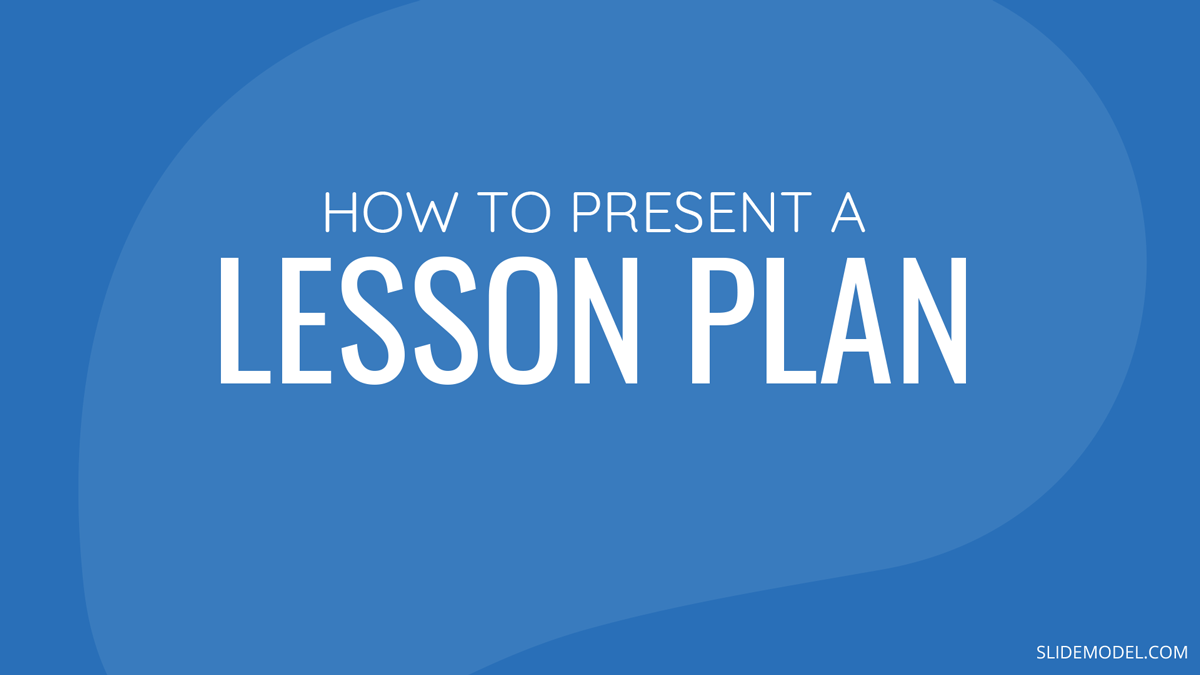
First days are always exciting, and expectation builds up about the contents of the task ahead, especially if you’re starting a class as a student or professor. This interaction will be significant because it will establish and define the subjects to be covered and the set of expectations flowing from the instructor towards the audience.
Perhaps you are ready to begin your career as a teacher and need some guidance; otherwise, you are a seasoned instructor searching for a refresher in your program. No matter which of the above you represent, the truth of the matter is that you are probably seeking a better way to introduce the subjects you’ll be teaching to your students.
What is a lesson plan?
A lesson plan will be the set of subject matter materials you will be teaching during a specific timeframe. The lesson plan should be an index that students can constantly consult to understand better the parts of the learning journey they will go through during each session.
Teachers and professors should have a lesson plan template that happens in every session. This is different from a syllabus because, in the latter case, the whole curriculum of the program will be laid out; however, for each lesson, there should be one individual lesson plan example to guide the instructor in the set timeframe.
When building the materials for the class or lesson’s attention, it’s always essential to share elements like the purpose or rules that guide the learning process . This article will explore the best way to present a lesson plan and drive a learning session successfully from the instructor or professor’s view.
How to write a lesson plan
Education nowadays guides different sorts of students and target specific learning needs. Therefore, it’s important and relevant to understand how lesson plans can change and be varied to truly implement the best learning path for your students. Once you have this part figured out, the next step is to understand how you will transmit the information and use a PowerPoint Presentation to simplify creating and presenting a lesson plan to your students.
Lesson plans will comprise several different sections that will clarify the first questions students can have: How long will the course be? Will it be an online course ? What will be the main objectives? Which subjects will be discussed along with the class?
1. Introduction
As the lesson begins, it’s essential to place a brief yet descriptive introduction about what the session will cover. A good practice is to create a catchy title for each lesson to have an overall understanding of the information they will be receiving.
Example: Digital Marketing Basics: Industry background, historical review years 1980-2010. In this session, we will cover the birth of digital marketing, including all the touchpoints that shaped today’s industry.
2. Audience
If your class is a one-time-only or recurring session, or even a blended learning journey, it’s essential to explain to your students who this class is for; this will allow them to calibrate their expectations about the matter to be taught ahead.
Example: This lesson is directed to professionals who work in traditional marketing, business owners, or communication specialists seeking to have a profound understanding of how digital marketing came to be.
3. Lesson Objectives
This piece is critical because it will allow the students to assess the intention of each lesson. When thinking about the objectives, it’s vital to consider the acquired skills we expect our students to have at the end of the class. Like any other goals in life or business, each one should be actionable and measurable, meaning after each class, students should be able to use what they have learned and put into action the concepts.
Example : Understand and be able to create a timeline framework of reference to explain the story of the Internet.
4. Materials
Suppose the lesson requires using any specific materials, physical or not, including any software or hardware necessary. In that case, it´s important to list or include within the lesson plan so students can set clear expectations on what they might require. This is particularly important if the session you will be delivering requires them beforehand to bring anything.
Example :
- Computer
- Scratch paper
5. Learning Activities
We´ve covered all the logistics by this point; however, now we need to start sharing the actual activities during the lesson. Ideally, this is a play-by-play of how each activity will guide the lesson towards the already established objectives. To add the list of learning activities that will be helpful for your students, take into account how all of them align with each goal and the requirements students need.
Make sure that you add variety to the activities that you are proposing, go ahead and research trends of how many other teachers or professors, students will appreciate your search to engage them in learning.
Also, consider how much time they will take so that you can note it in the next section.
- Create a timeline on the wall with the most important moments of digital marketing history, including creation of social media, mainstream of email, etc.
Time periods
Pairing each learning activity with a specific timeframe will be useful both for instructors and students. Make sure you calculate a reasonable amount of time for each activity and list it within the lesson plan so everyone can set correct expectations. Assigning time slots for each exercise will also help students and teachers stay on track with the lesson and not waste valuable time invested in learning.
Example : Creation of a timeline – 45 min
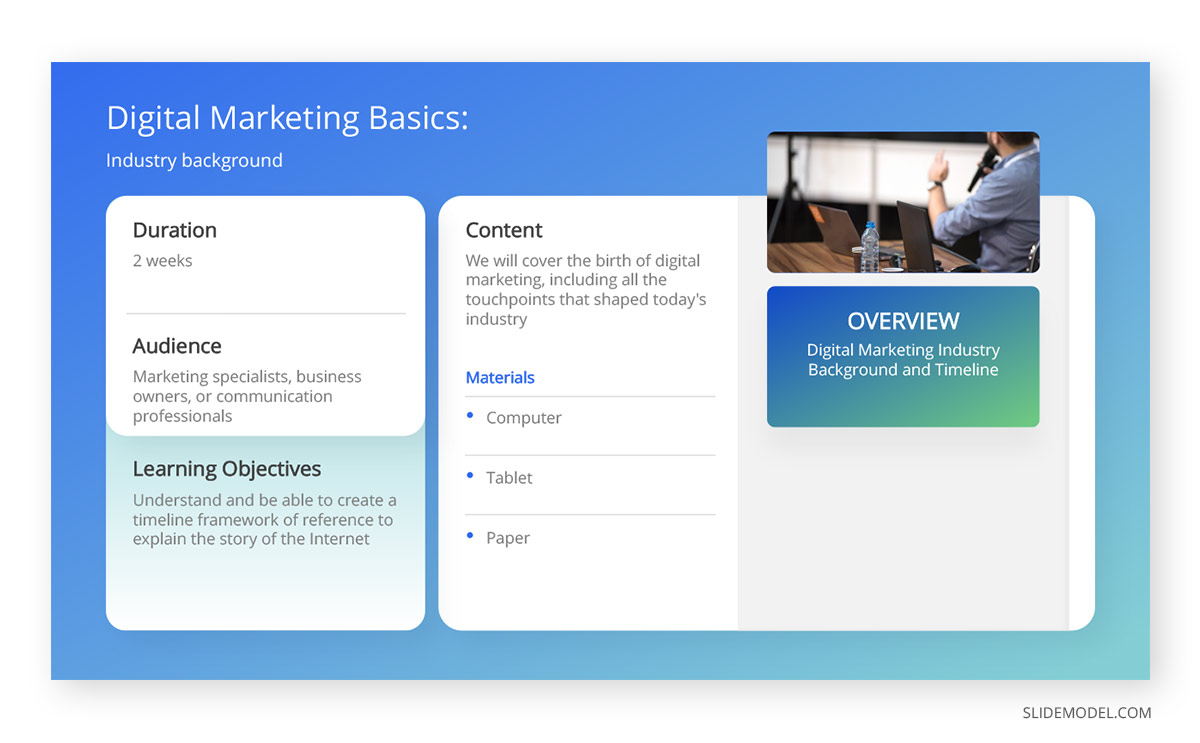
How to present a lesson plan
We have now listed the components of the lesson plan structure, everything looks beautiful in the draft, but now we need to start planning how we will present the program to the students. This part is challenging because you have to choose a template that makes sense for you and will be helpful for your students to understand.
A PowerPoint presentation is a great way to showcase all the contents of the lesson plan, however, the trick is to decide how you want to structure it.
Lesson Plan Design
By this point, you’ve structured a lesson plan template that can go through any test. Nevertheless, creating the materials to accompany it can be a key in the commitment generates between the students and the professor.
Design and Style
Before adding any text to your presentation template , think about the requirements you have: Does the academic institution where you work require the use of logos? Do you have to follow any visual guidelines? This might be important for the cohesiveness of your presentation.
It’s essential to think about how you would like to present the lesson plan. You may want to keep it simple and have a 1 pager and talk through it to understand your students fully, or perhaps you need to create one full presentation where every slide will be a relevant piece of information. Let’s explore this a bit further.
One Pager Lesson Plan
If your style is more towards simplicity, this is a great solution: succinct, minimalistic, and straight to the point. You can complete a one-page lesson plan with bullets of the relevant data and send it out to students. A great advantage of this format is that you can either send it as a PDF or even as a single image (JPG or PNG), exporting it directly from PowerPoint.
One significant advantage is that your students will only have to check for one source by choosing this simple format when revising the lesson during the class or afterward.
Several pages lesson plan
Almost like a syllabus, a more extended presentation will include several slides so you can include the information in different formats.
For example, you can use the first slide to include the lesson title; afterward, a new slide can define the purpose or introduction of the lesson. In the upcoming slides, you can include materials, contents, and even ad charts or similar to explain how grades will be affected by each lesson’s assignments on the upcoming slides.
Text in the presentation
It’s always good to follow the reliable practices of presentations and include the necessary information without overwhelming students. Don’t add an excessive amount of text to one slide; actually, make sure that every piece of data is helpful for students to plan their time both during and after class.
However, if you will be sending out the presentation to your students before reviewing it, consider that they will be using it for their reference to follow through with your lesson. So make sure all the information is easy to read and accessible.
Additional elements
Learners of all sorts have become increasingly visual, so don’t be afraid to add infographics, images, photographs, icons or any other elements to make your lesson plan presentation more appealing visually.
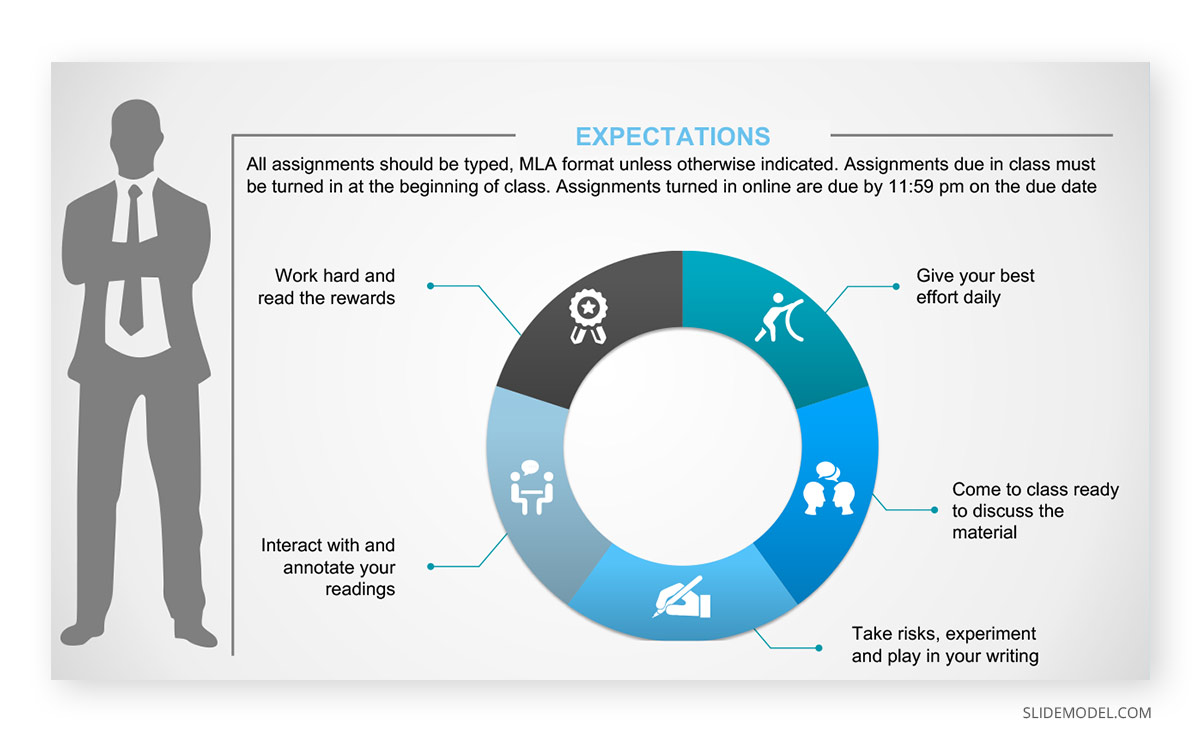
Final Words
Remember the lesson plan presentation will be the first approach your students will have with the subject matter. Take your time, enjoy the process, and create comprehensive and attractive lesson plan slides that will inspire your students to have thoughtful and deep learning.
1. 1-Slide Lesson Plan PowerPoint Template
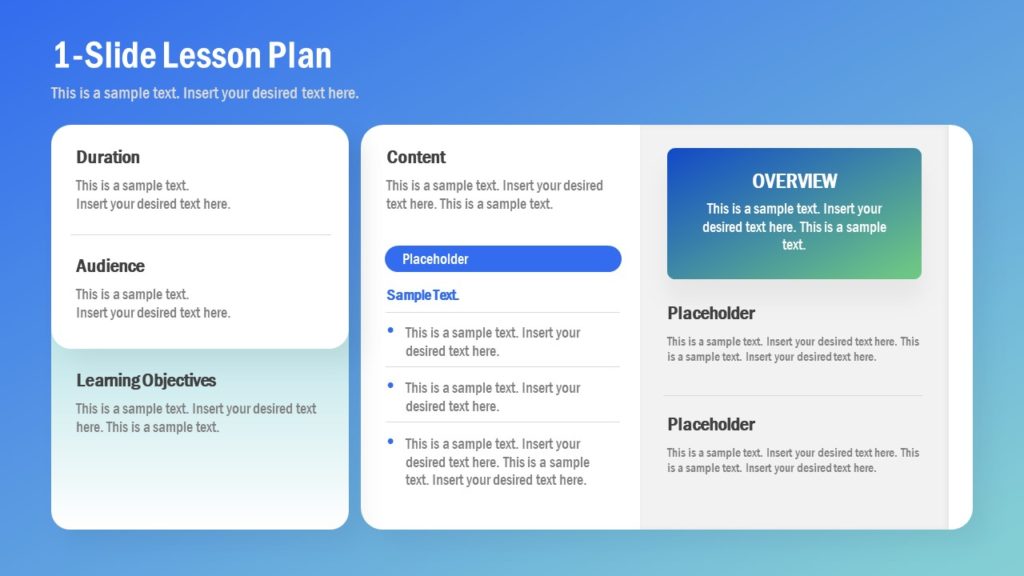
Create a simple and minimalist one-pager lesson plan for your academic uses, course planning, and even as student handouts, with this eye-catching PowerPoint template.
Use This Template
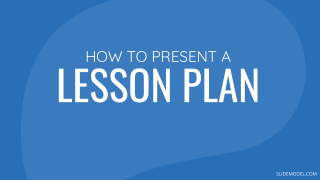
Like this article? Please share
Learning Experience, Learning Styles, Presentation Approaches, Presentation Tips, Presentations Filed under Education
Related Articles

Filed under Design • April 23rd, 2024
How to Create the Perfect Handouts for a Presentation
Learn how to create effective handouts for presentations and the recommended structure for handouts with this guide.
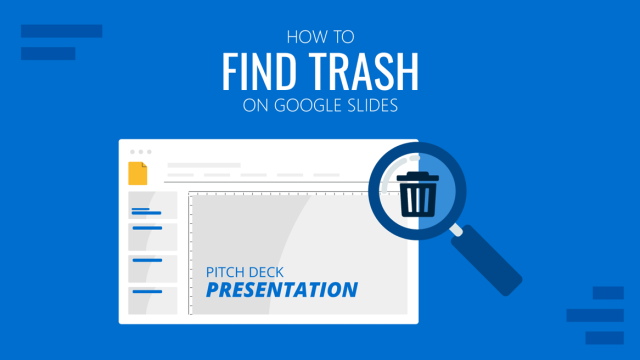
Filed under Google Slides Tutorials • April 19th, 2024
How to Find Trash on Google Slides
Don’t worry if you accidently delete a presentation file. Learn how to find trash on Google Slides with this guide.

Filed under Business • April 10th, 2024
Discovering Coaching Presentation Tools
Discover the best PPT templates to use as coaching presentation tools with this article. Tools explained + examples.
Leave a Reply
How to Create an Effective Lesson Plan Presentation
Regardless of the subject or content you’re teaching, having a lesson plan in place prepares you for class by offering detailed guidelines for the session. The lesson plan doesn’t have to be lengthy or complex—it just needs to include elements about what you’re teaching, the method of presenting this material, and what objective and goals you wish your students to achieve as part of the curriculum.
Why Lesson Plans Are Important
It’s crucial for teachers to prepare their lessons in advance and implement the best teaching approaches. Attending a session without a lesson plan can be counterproductive for both students and teachers. Without the right preparation beforehand, classes can end up being unproductive or confusing.
Below are a few reasons why you should consider lesson planning:
Lesson Planning is Handy for Classroom Management
Developing the lesson plan from the learning objectives provides flexibility in adapting to different teaching methods and classroom management techniques. For instance, hybrid or online classes require a different delivery approach from the traditional classes, which means making modifications to any existing plans. With the right foresight and plan in place, classes can stay on topic and effective. Such circumstances underscore how crucial lesson plans are in ensuring that the class runs smoothly, regardless of the learning environment.
Lesson Planning Creates Student Success
Various studies have shown that students benefit immensely from and appreciate well-structured lessons. Thus, success is more likely when students engage and show interest in the material being taught. Using a curriculum guide, teachers can develop valuable lesson plans based on specific objectives and goals (what’s intended for students to learn).
Lesson Planning Is Central to Teacher Success
Teachers’ success is, to some extent, pegged on students’ success. Besides that, the documents you develop as part of the lesson planning process are often part of your assessment by school administrators. What’s more, as you advance your teaching career, your lesson plans serve as a repository for your expanding body of knowledge. Thus, the significance of lesson planning cannot be overlooked when it comes to advancing your career as an educator.
Lesson Planning is Vital in Student Assessment
Lastly, lesson plans turn the learning sessions into clear objectives for students and a way to gauge their understanding of the subject matter. One notable benefit of the lesson plan is tailoring the assessment to a particular objective while considering students’ specific needs. You can use common assessment methods such as quizzes, tests, and homework assignments.
How to Write a Lesson Plan
Lesson plans include different sections that clarify questions students might have about the subject on hand. What are the lesson objectives? What subjects will be covered during the session? How long will the course take?
- Introduction – As the lesson commences, it’s good to have a concise yet vivid introduction about what the lesson will cover. The ideal practice is to create a memorable title for every lesson to create a general understanding of the learning material students will be interacting with.
- **Lesson Objectives –**This section is critical as it allows the students to ascertain each lesson. When it comes to objectives, it is crucial to consider the acquired skills you expect the students to gain by the end of the session. Each objective should be measurable and actionable; meaning after every session, students should be able to apply what they’ve learned.
- Learning Activities – This should be a detailed account of how each activity will lead the class to achieve its predetermined goals. To create valuable activities, consider how each learning activity fits each objective, and the requirements students need.
- Practice – Practices are primarily intended to assess students’ comprehension of the material and aid in memorizing what they have learned in class. Therefore, it is crucial to include this in the lesson plan so that assessments can always be done at the appropriate time.
Today, lesson planning has been made less time-consuming and easier, thanks to smart whiteboards for the classroom . A digital whiteboard like the Vibe Board Pro provides unmatched performance that shows you know your craft and are way ahead of the pack.
Download Our New E-book
The Future of Learning
Download Our New E-book The Future of Learning
Read our privacy policy .
We’ve sent you an email with the PDF download link. Enjoy!
Can't wait? Read now
How Smart Whiteboards Simplify Lesson Plan Creation and Presentation
Not only does using a smart whiteboard make learning accessible , it’s also a great way of enhancing and enriching your lesson plans with interactive activities for the class. Smart whiteboards function as a touch screen for all; during class sessions, you and your students can use it as a digital whiteboard to create a space where students’ engagement, knowledge, and teamwork are appreciated.
While the smart whiteboard aids in making your lesson more engaging, interactive, and educational, you as the teacher can still customize your teachings to what you want them to be. This helps in foiling any hitches in your lesson presentation and makes switching from one topic to another seamless.
Below are more specific ways how smart whiteboards make your lesson plan presentation better:
Take Advantage of Built-in Templates
Once you invest in a smart whiteboard, make sure to take advantage of the wide variety of built-in lesson planning templates. You can use these templates to improve lesson plans while leveraging the technology associated with smart whiteboards. Even better, these templates can be easily customized for every lesson plan and cover different subject matters, allowing you to create new lesson plans without always starting from scratch quickly. How cool is that?
Organize and Present Lesson Plans Better
Smart whiteboards combine the power of the traditional whiteboard and a TV/projector into one hub, allowing you to write on the board while concurrently projecting it to the classroom. This allows you to conduct lesson plan presentations on a larger scale while also letting students see what’s going on.
For instance, if you’re presenting on an extensive topic involving multiple subtopics, a smart whiteboard will help you walk students through each subtopic with ease. Begin with the presentation divided into primary or main sections, highlight key definitions, and add infographics and videos to ensure that every student understands the tiniest detail.
Additionally, you can get students involved in the lesson plan presentation by asking questions, polling them on key points, or allowing them to follow along on their tablets or laptops.
Record Lesson Plan Presentations
Another benefit of using smart whiteboards in the classroom is that a lesson plan presentation can be recorded and accessed long after the session is over. This allows your students to access the material on their own time.
Final Words: Creating a Lesson Plan Presentation
Lesson plan presentation offers students the first interaction with the material they will learn. Take your time, appreciate the process, and create an attractive and comprehensive lesson plan that will encourage your students to have deep and thoughtful learning experiences. Even better, all of this can be made easier with smart whiteboard technology. Leave the spiral notebooks and sticky notes at home. A smart whiteboard is all you need.
What is the presentation stage in lesson planning?
Presentation is usually the core of the lesson plan. During this stage, theteacher introduces the topic and the key subject matter the students need to master. Presenting with smart whiteboards is exceedingly easy and less time-consuming.
What are the 5 steps in lesson planning?
The five steps are:
- Objective: A learning concept or objective is introduced.
- Warm-up: Revise the previous lesson
- Presentation: Present the material using suitable tools and techniques.
- Practice: Students try to apply what they have learned.
- Assessment: Evaluate whether the objectives were achieved
How does lesson planning help teachers?
Planning lessons in advance allows teachers to arrive at class each day prepared to introduce new concepts and facilitate engaging discussions rather than improvising as they go. In other words, without a lesson plan, teachers may be left scrambling, making students lose interest in the material to be learned.
Subscribe to get updates on all things at Vibe
- Grades 6-12
- School Leaders
Get our FREE Mother's Day Printable 💐!
30 Lesson Plan Examples for Every Grade Level and Subject
Lots of ways to prepare for top-notch learning.
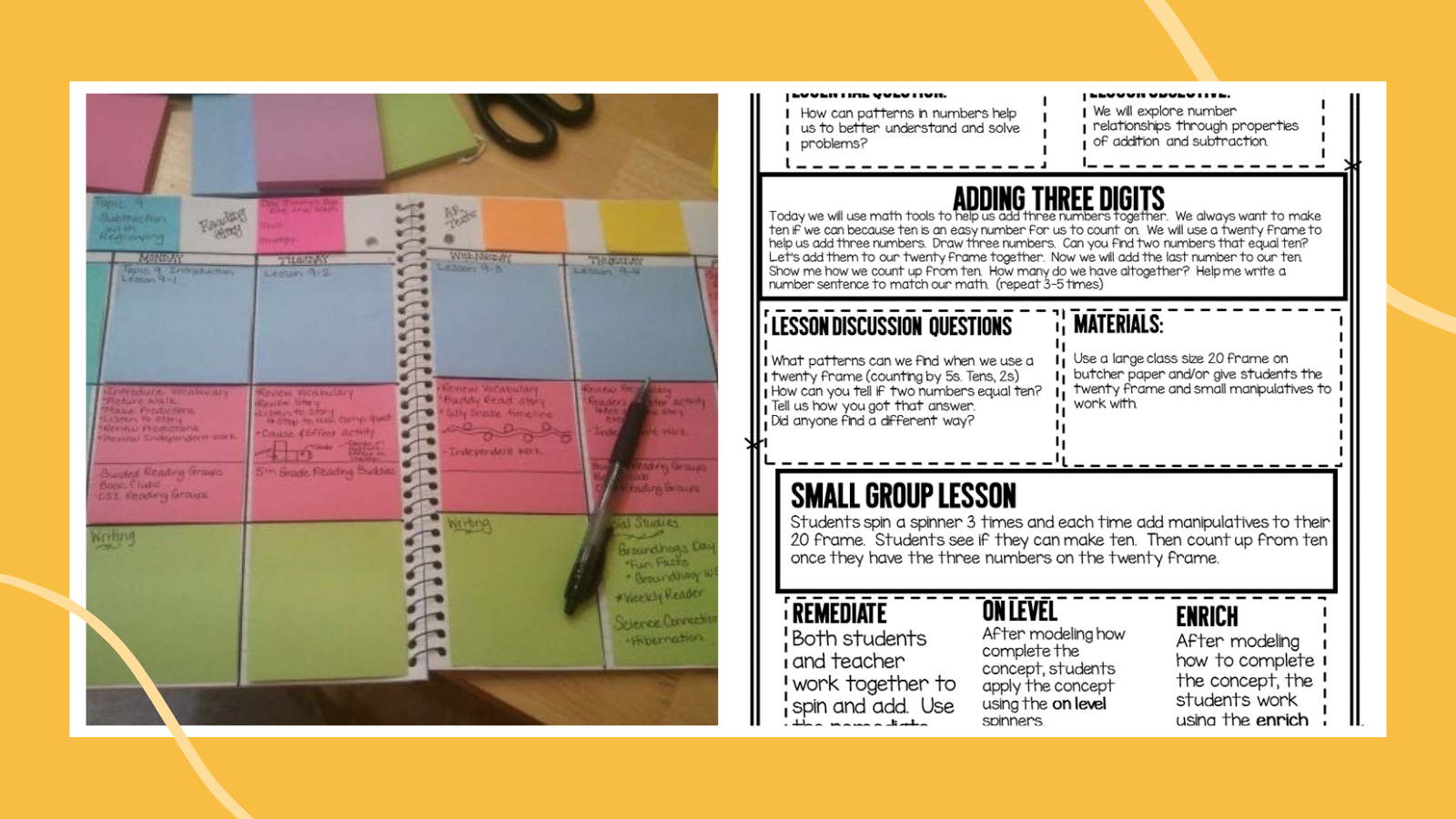
Writing lessons might be a fun activity for you (all the things you’ll do!) or it may be a necessary evil (so many boxes to fill). Either way, it’s an important part of teaching and can make or break your week, month, and year. Whether you’re a brand-new teacher or an experienced educator looking for some new ideas, these lesson plan examples offer inspiration for every subject and every grade level.
Lesson Plan Sections
Preschool lesson plan examples, elementary school lesson plan examples, middle and high school lesson plan examples.
Many lesson plans include some or all of the following sections.
- Objective : These should be specific and measurable. Often they align with Common Core or other learning standards.
- Materials: List any items you’ll need, including worksheets or handouts, school supplies, etc.
- Activities: This is usually the longest section, where you’ll lay out what the lesson and its activities look like. Some teachers write these in great detail. Others include just an overview to help them plan.
- Assessment: How will you assess your students’ learning? This could be a formal assessment or something simple like an exit ticket. ( Get lots of formative assessment ideas here. )
- Differentiation: Describe how you’ll vary the level of difficulty for students at all levels, including any enrichment for early finishers.
Some people think preschool is just playtime, but pre-K teachers know better! Here are some of the ways preschool teachers plan for their lessons.
Weekly Lesson Plan
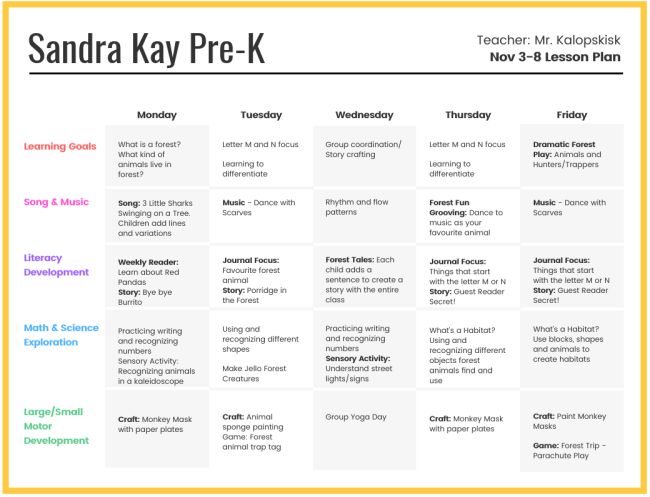
Venngage/pre-K lesson plan via Venngage.com
Weekly preschool lesson planning helps you plan each day and ensure you’re tackling all the most important skills.
Learn more: Venngage Pre-K Weekly Lesson Plan Template
Pre-K Theme Lesson Plan
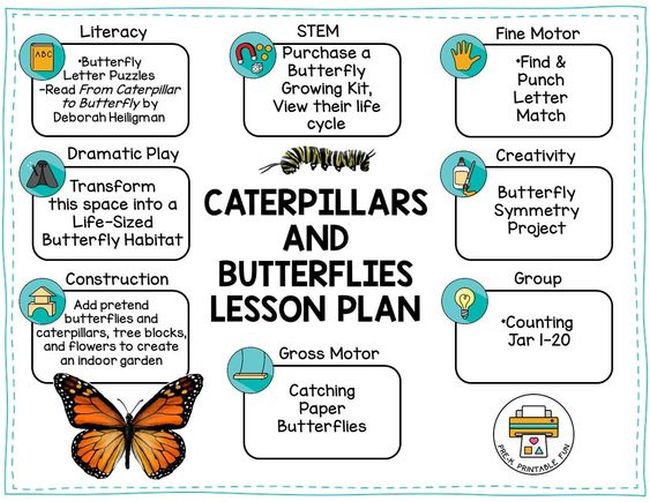
Pre-K Printable Fun/Caterpillar and Butterfly Lesson Plan via PreKPrintableFun.com
If you like to plan by theme, try a template like this. It includes space for a variety of activities that fit your topic.
Learn more: Pre-K Printable Fun
Alphabet Letter Lesson Plan
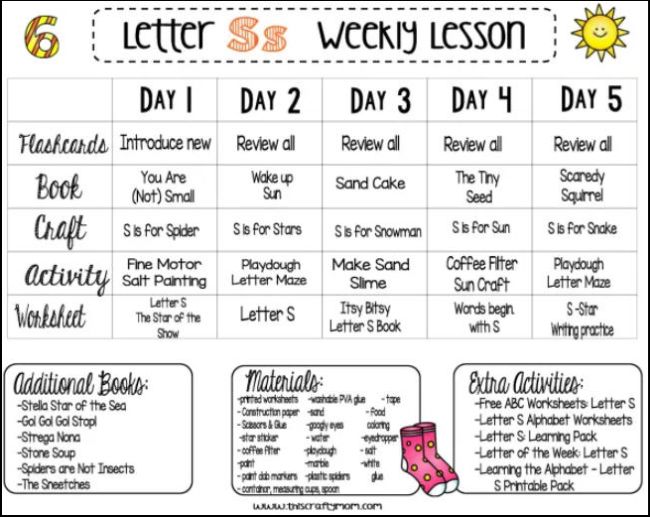
This Crafty Mom/Letter S Lesson Plan via ThisCraftyMom.com
If you’re focusing on a new letter of the alphabet each week, try lesson planning like this. You can see the week at a glance, including all the materials and books you’ll need.
Learn more: Alphabet Letter Lesson Plan by This Crafty Mom
Centers Lesson Plan
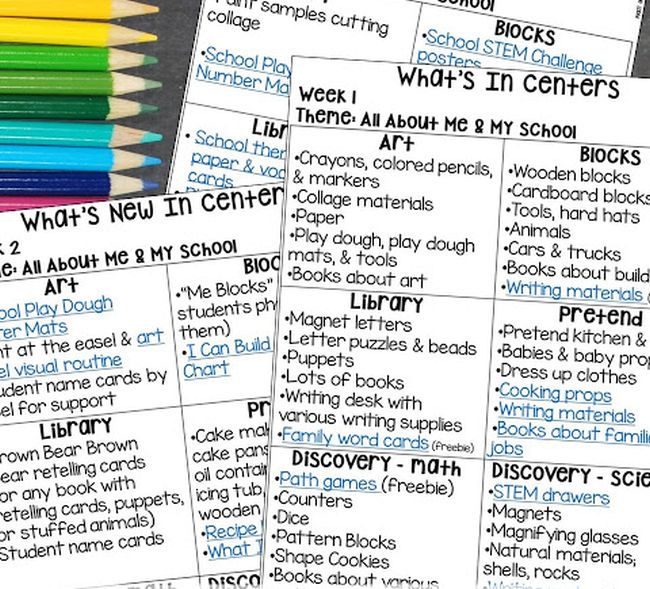
Pocket of Preschool/Centers Lesson Plans via PocketofPreschool.com
Your centers need some planning too! Whether you change them out weekly, monthly, or as needed, use plans like these to stay prepared.
Learn more: Pocket of Preschool
Weekly Unit Lesson Plan
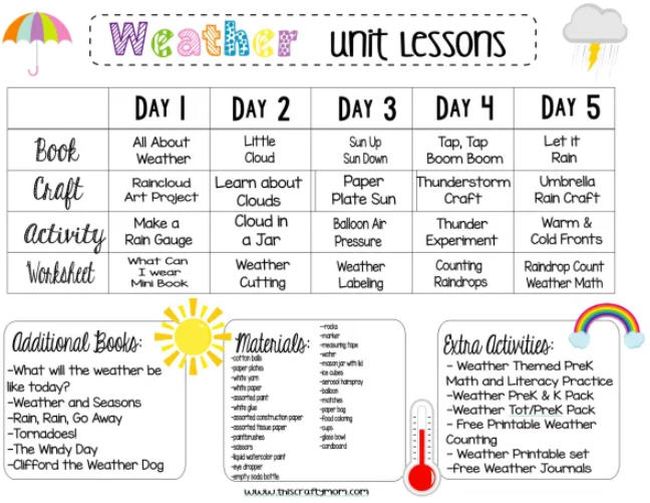
This Crafty Mom/weather unit lessons via ThisCraftyMom.com
Adding pops of color and a few images can make it easier to locate the lesson plan you’re looking for in a snap!
Learn more: Weekly Weather Unit Lesson Plan by This Crafty Mom
Since elementary teachers tackle multiple subjects every day, their lesson plans might look like a general overview. Or they may prepare more detailed lesson plans for each topic to help them stay on track. The choice is up to you.
Weekly Overview Lesson Plan
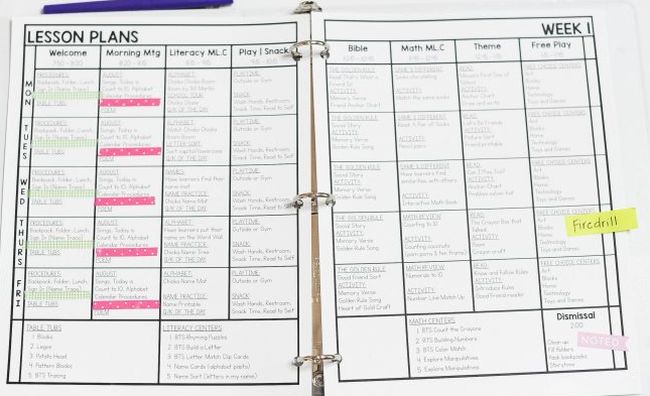
Mrs. Jones Creation Station/lesson plan example via MrsJonesCreationStation.com
Don’t be afraid to write out your lesson plans by hand! A side-by-side setup like this lets you see a whole week at once. We love the use of color to highlight special things like fire drills.
Learn more: Mrs. Jones Creation Station
Yearlong Schedule
Planning a whole year may seem daunting, but it can show you where you’re going to need to stretch a unit and where you can circle back and review. Mrs. D from Mrs. D’s Corner has ideas on how to structure a yearlong lesson plan using Google Sheets.
Learn more: Mrs. D’s Corner
Guided Math Lesson Plan
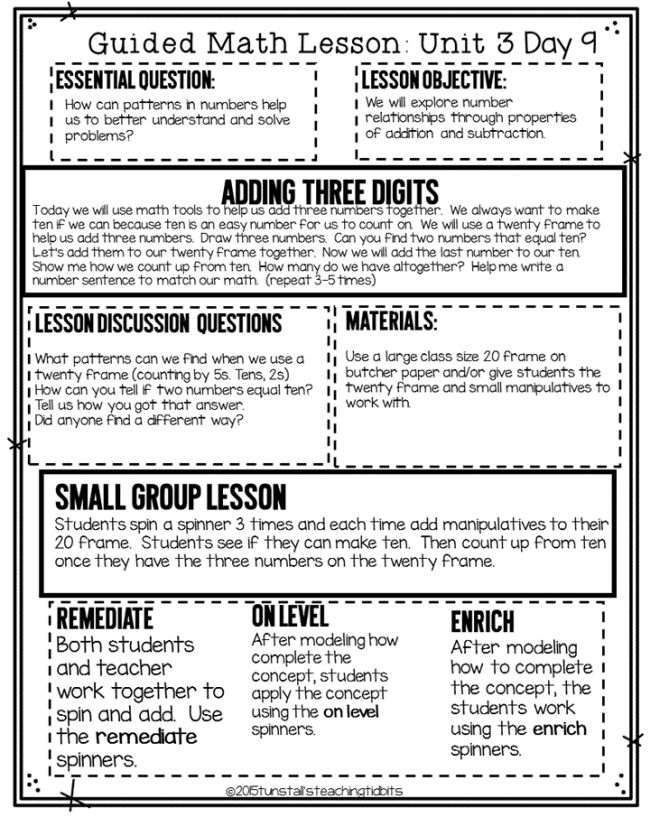
Tunstall’s Teaching Tidbits/Guided Math lesson plan example via TunstallsTeachingTidbits.com
This example on adding three numbers together can be altered to fit any math lesson plan.
Learn more: Tunstall’s Teaching Tidbits
Art Lesson Plan
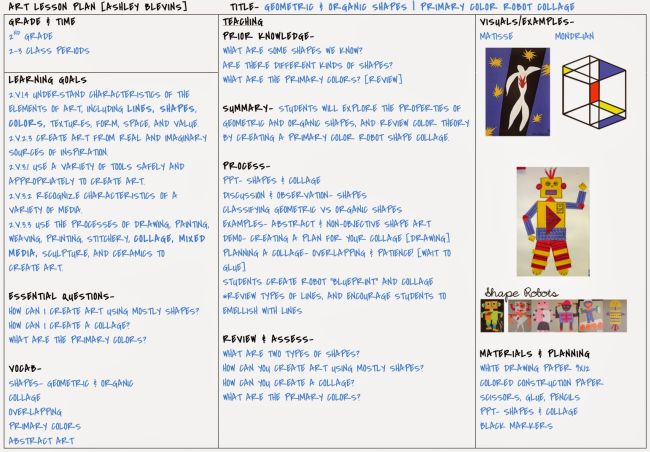
Artsy Blevs/lesson plans via TeachandShoot.com
While these are elementary art lesson plan examples, you can easily use this style for teaching art at upper levels too.
Learn more: Artsy Blevs
Special Education Lesson Plans
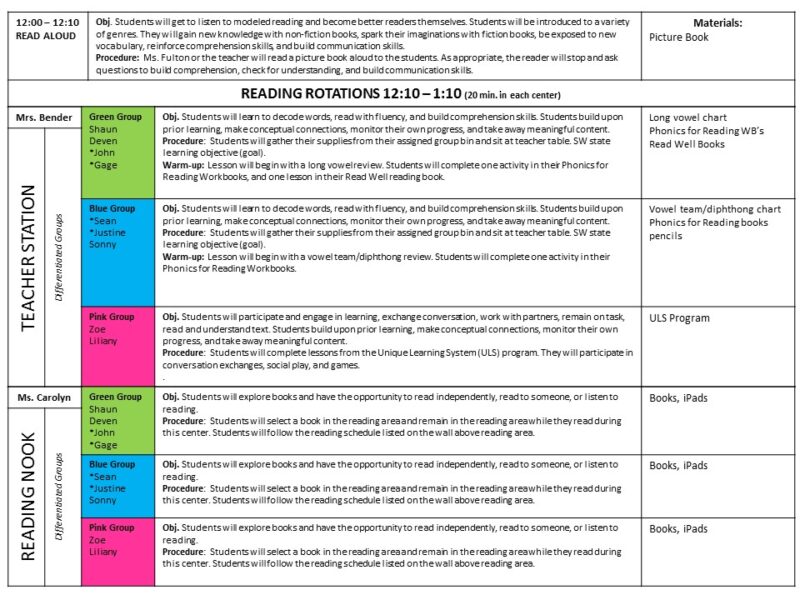
The Bender Bunch/lesson plan example via TheBenderBunch.com
Lesson planning for special education looks different than general classroom lessons in that the lessons have to cover specific IEP goals and include lots and lots of progress monitoring. The Bender Bunch starts each lesson with independent work (read: IEP practice) and then heads into mini-lessons and group work.
Learn more: The Bender Bunch
Interactive Read-Aloud Plan
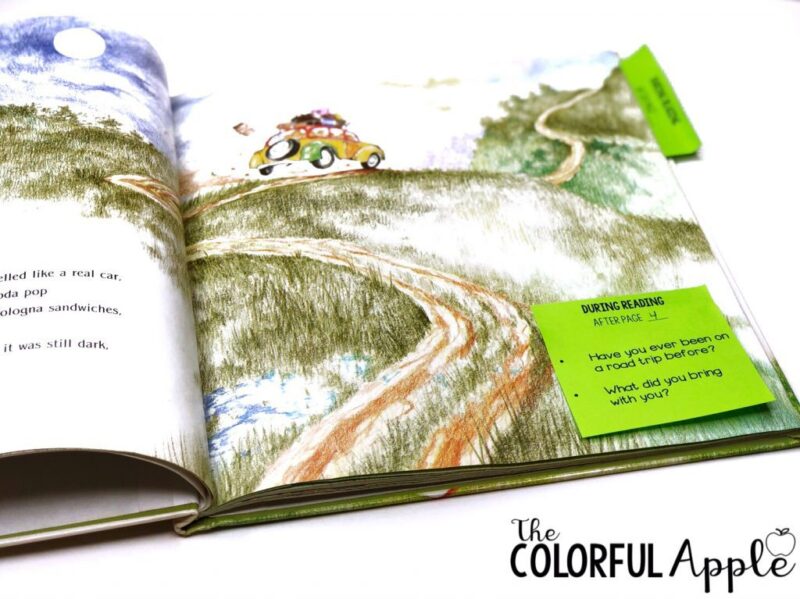
The Colorful Apple/interactive read-aloud lesson plan example via TheColorfulApple.com
Interactive read-alouds aren’t something that should be “on the fly.” The Colorful Apple explains how to choose a book, get to know it, and get ready to teach it. Once you’re in the book, sticky notes may be the best lesson-planning tool you have for marking questions and vocabulary words you want to point out to students.
Learn more: The Colorful Apple
Social Studies Lesson Plan
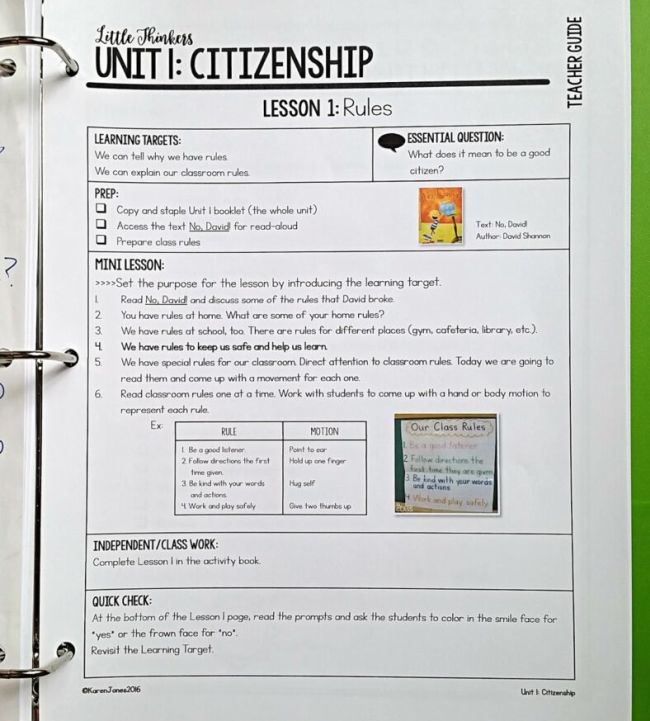
Mrs. Jones’s Class/social studies lesson plan example via MrsJonessClass.com
Including images of your anchor charts is a great idea! That way, you can pull one out and have it ready to go in advance.
Learn more: Mrs. Jones’s Class
5E Lesson Plan for Elementary School
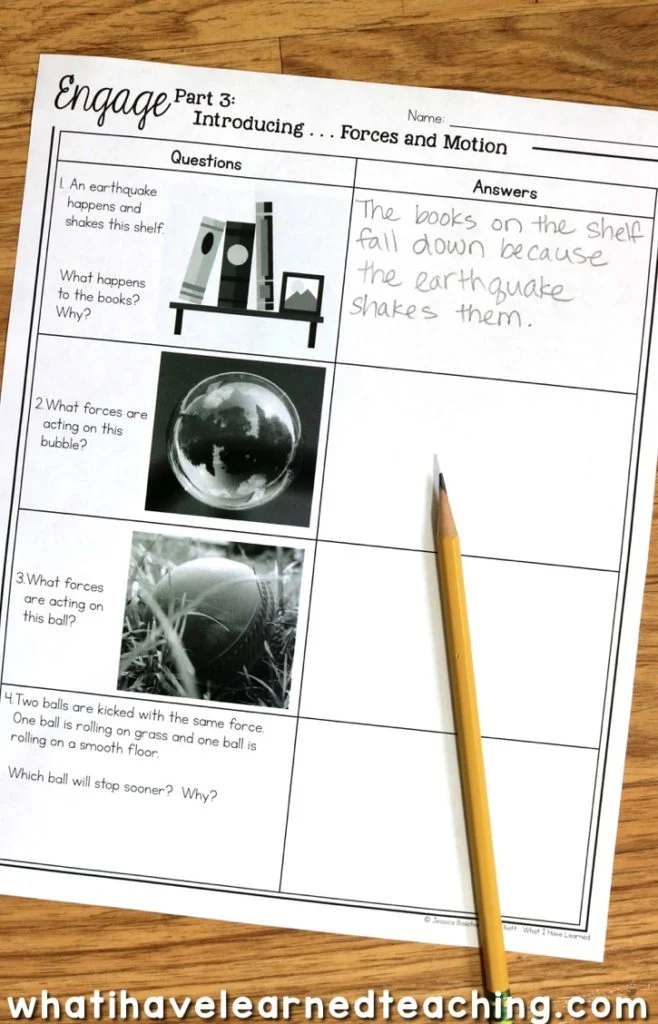
What I Have Learned Teaching/example from 5E lesson planning via WhatIHaveLearnedTeaching.com
The 5Es stand for Engagement, Exploration, Explanation, Elaborate, Evaluate. This type of lesson planning can be helpful for students as they work through each of the 5Es related to the topic you’re studying.
Learn more: What I Have Learned Teaching
Science Lesson Plans
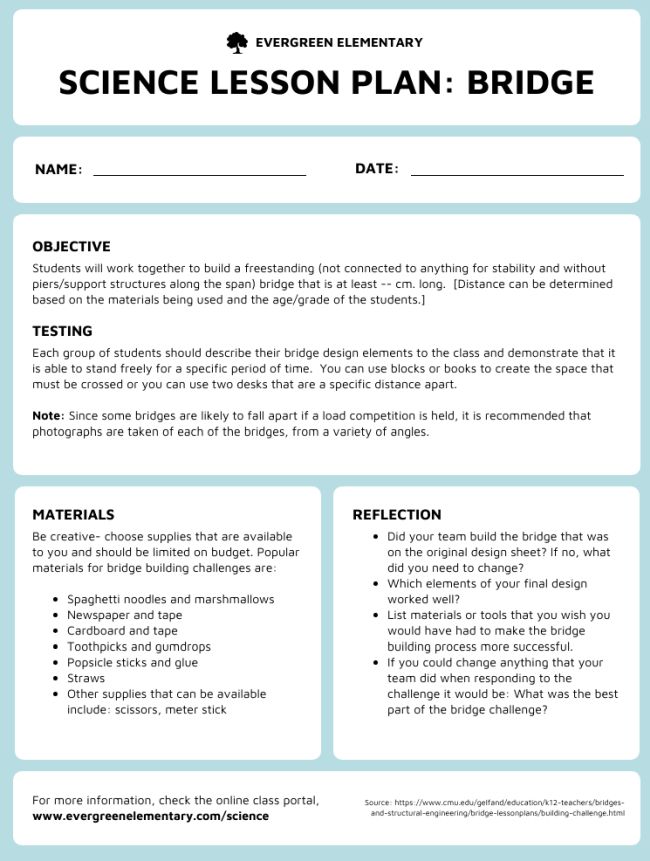
Venngage/Science lesson plan example via Venngage.com
If you like to plan your lessons in more detail, take a look at this elementary science lesson plan example.
Learn more: Venngage Science Lesson Plan Template
Reading Groups Lesson Plan
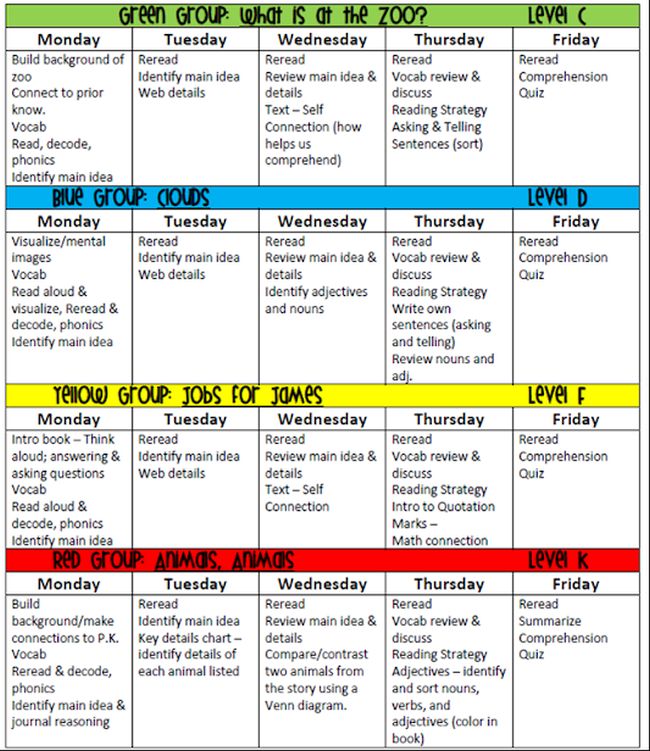
First Grade Fairy Tales/reading groups lesson plan via TheFirstGradeFairyTales.com
Lots of elementary schools have differentiated reading groups. Use a template like this one to plan for each one, all on one page.
Learn more: The First Grade Fairy Tales
P.E. Lesson Plan
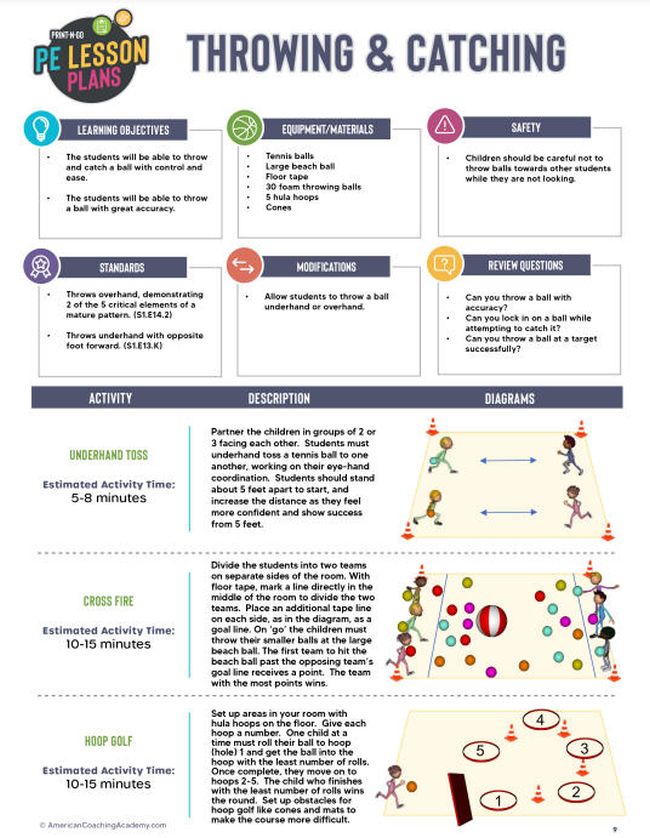
American Coaching Academy/P.E. lesson plan via AmericanCoachingAcademy.com
Gym teachers will love this lesson plan idea, which includes directions for playing the games.
Learn more: American Coaching Academy
Music Class Lesson Plan
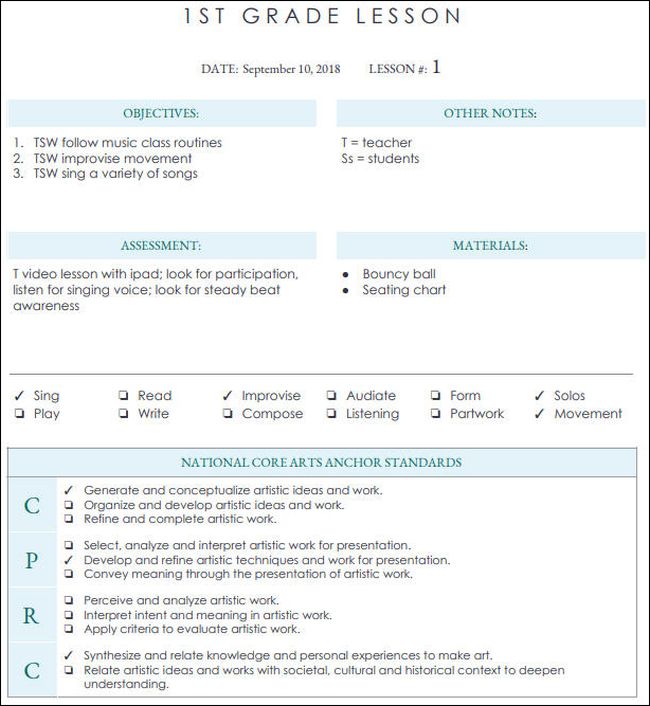
Victoria Boler/music lesson plan via VictoriaBoler.com
Plan out the skills and songs you’ll need for a meaningful music class with a lesson plan like this one.
Learn more: Victoria Boler
At the middle and high school levels, teachers often need more detailed plans for each class, which they may teach multiple times a day. Here are some examples to try.
Google Sheets Lesson Plans
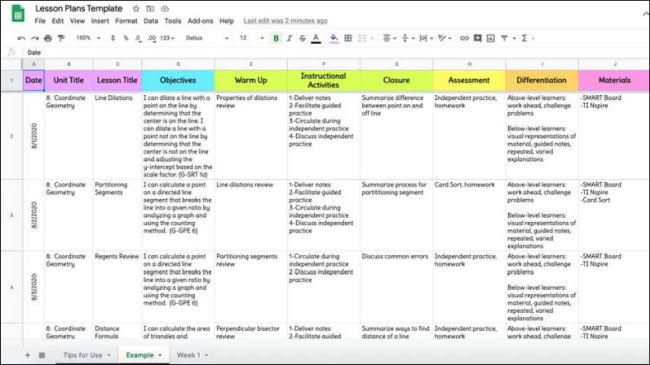
Busy Miss Beebe/Google sheets lesson plan example via BusyMissBeebe.com
Google Sheets (or Excel) is terrific for lesson planning! Create a new tab for each week, unit, or class.
Learn more: Busy Miss Beebe
Weekly History Plan
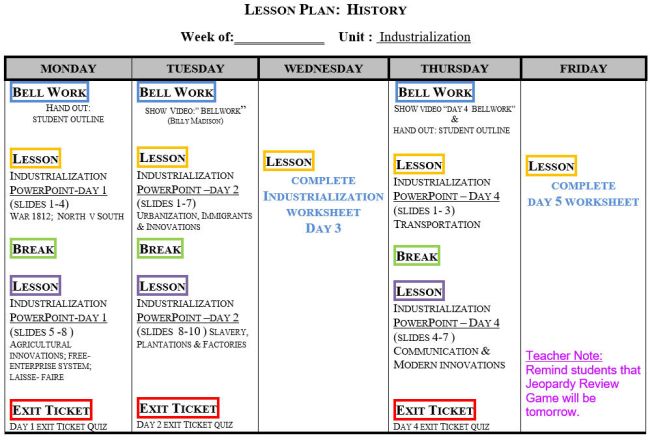
Teachers Pay Teachers/Coaching History lesson plan via TeachersPayTeachers.com
This example shows how you can plan out a week’s worth of lessons at once, and see the entire week all in one spot. This example is for history, but you could use this for math, ELA, or social studies too.
Learn more: Coaching History on Teachers Pay Teachers
Outline and Pacing Guide Lesson Plan
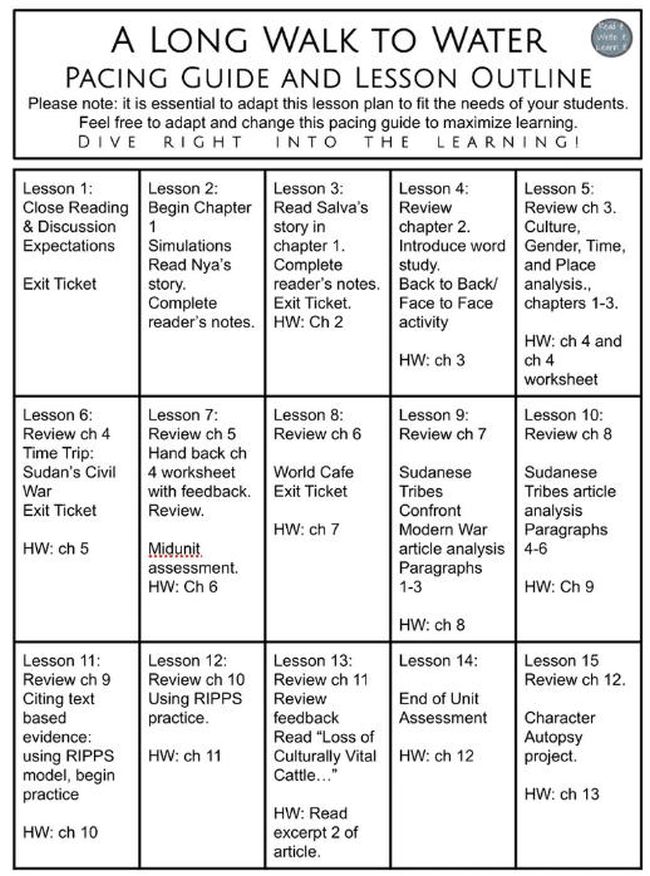
Read it. Write it. Learn it./pacing guide example via ReadItWriteItLearnIt.com
A pacing guide or outline works for both you and your students. Share it at the beginning of a unit to let them know what’s ahead.
Learn more: Read it. Write it. Learn it.
5E Lessons in Middle and High School
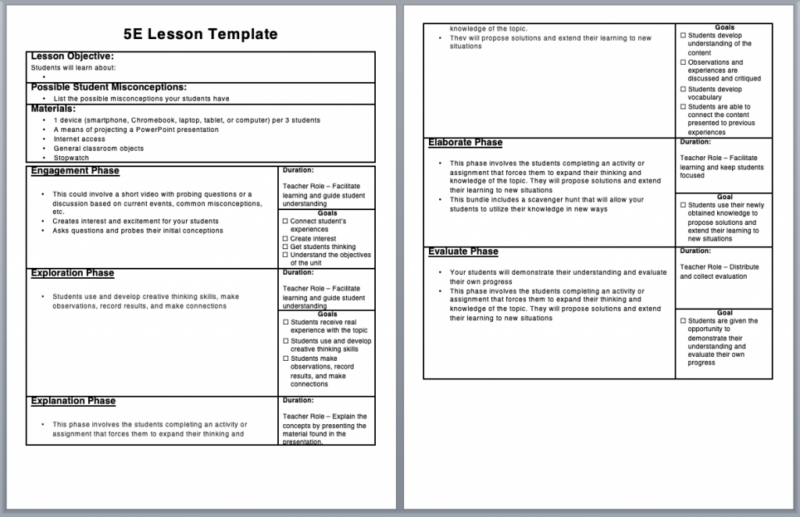
Teach Science With Fergy/5E lesson plan via TeachScienceWithFergy.com
5E lesson plans (Engagement, Exploration, Explanation, Elaborate, Evaluate) are great for middle and high school as well. This example is for science, but you can use the 5E structure across all lessons.
Learn more: Teach Science With Fergy
Math Intervention Plans
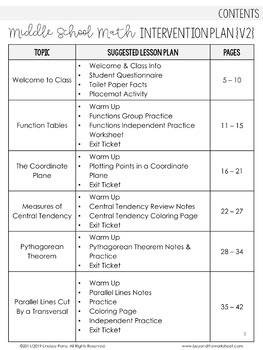
Lindsay Gould/middle school math lesson plan via TeachersPayTeachers.com
When students are in math intervention, they’re reviewing material they learned last week or last year. Lesson plans need to provide time for them to activate their prior knowledge (and make sure they’re remembering it all correctly) before reteaching and practice.
Buy it: Teachers Pay Teachers
The Sticky-Note Lesson Plan
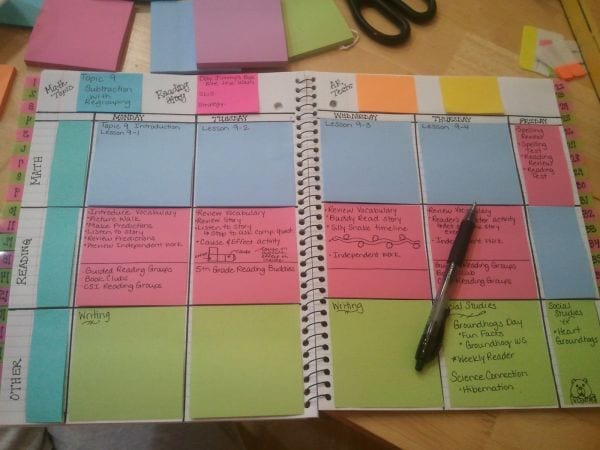
The Wise & Witty Teacher/sticky note planner via WiseWittyTeacher.com
At some point, you’ll know what students are doing each day, you’ll just need some reminders for questions to ask and key points to cover. The nice thing about using sticky notes for lesson planning is if you get ahead or behind schedule, you can move the entire sticky note lesson to another day.
Learn more: The Wise & Witty Teacher
Read more ways to use sticky notes in the classroom .
Backwards Planning Lesson Plan
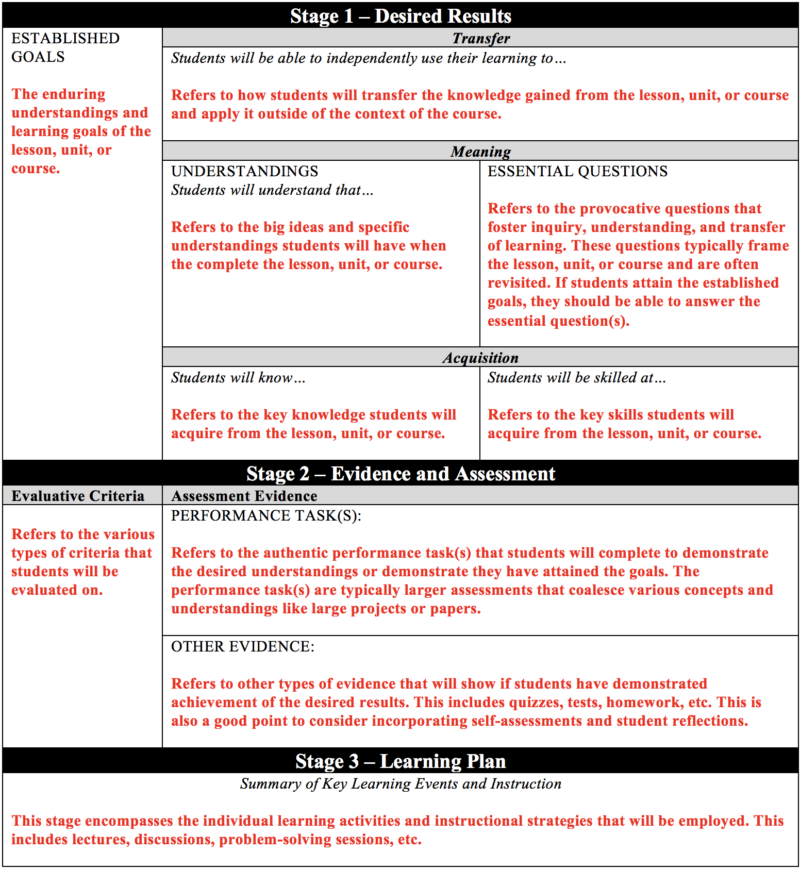
Vanderbilt University Center for Teaching/Understanding by Design lesson plan example via cft.vanderbilt.edu
If your school uses Understanding by Design or other backwards planning, you’ll be thinking about the outcome first and working back from there (rather than forward from an activity or task). Backwards planning lesson plans are intensive, but they’re also something you can use over and over, modifying them slightly for each group of students you have.
Learn more: Vanderbilt Center for Teaching
Visual Arts Lesson Plan
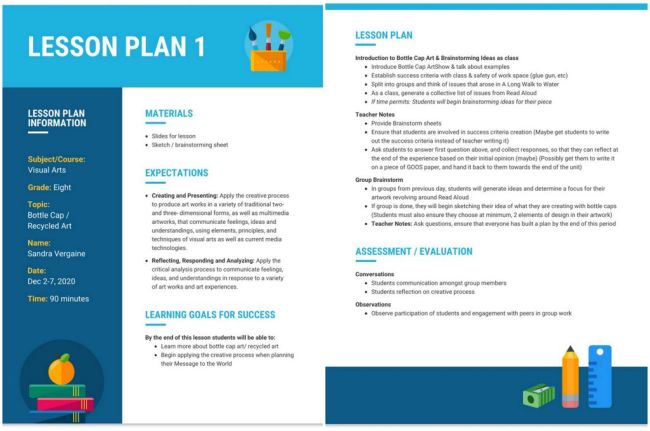
Venngage/visual art lesson plan example via Venngage.com
Detailed lesson plans take longer to prepare, but they make it easier on the day (especially if you wind up needing a sub).
Learn more: Venngage Visual Arts Lesson Plan Template
ESL or Foreign Language Lesson Plan
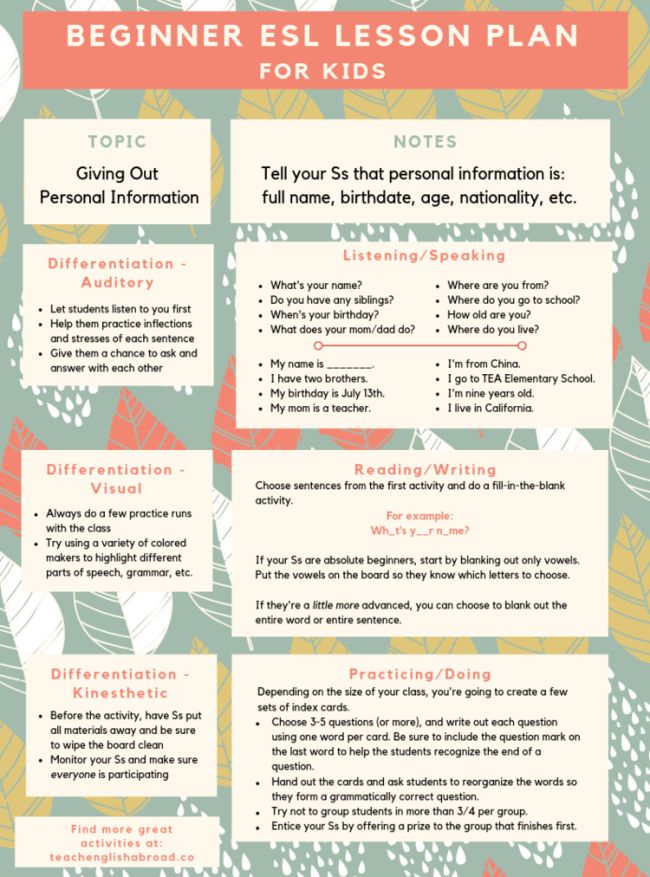
TeachEnglishAbroad.co/ESL lesson plan via TeachEnglishAbroad.co
Whether you’re teaching English as a second language (ESL) or a foreign language to English speakers, this lesson plan style is perfect.
Learn more: Teaching English Abroad
Music Lesson Plan
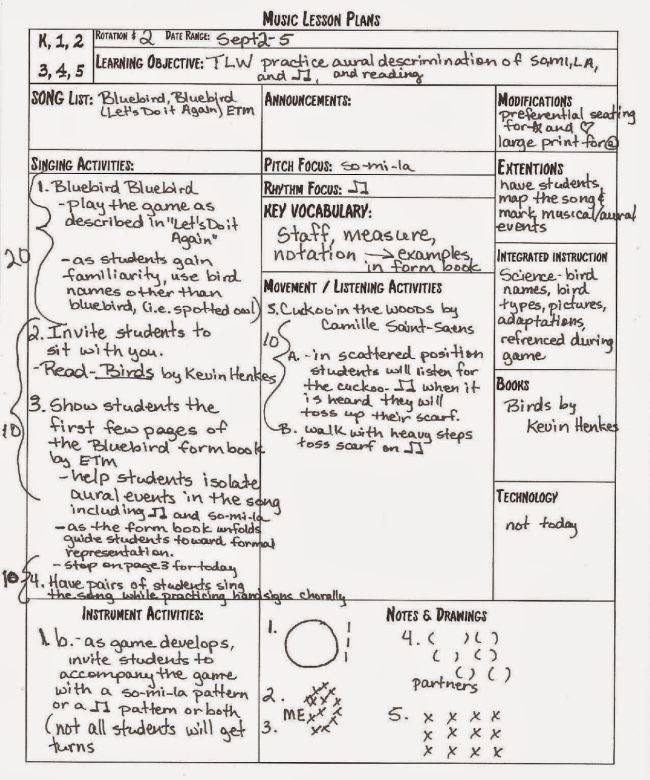
Melody Soup/lesson plan example via MelodySoup.Blogspot.com
Use a lesson plan like this for choir, orchestra, band, or individual music lessons.
Learn more: Melody Soup
Blended Learning Lesson Plan
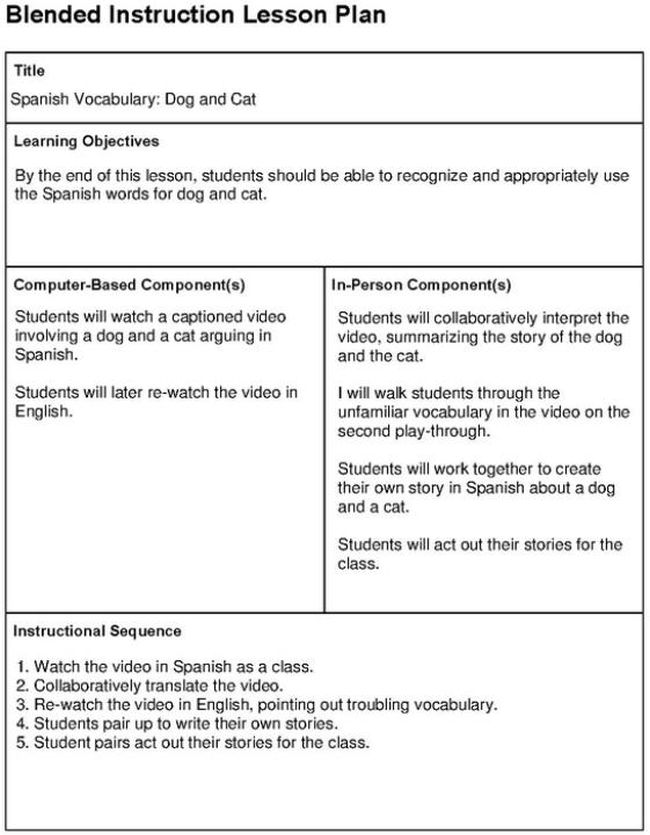
Hot Lunch Tray/blended learning lesson plan example via HotLunchTray.com
If your instruction includes both computer-based and in-person elements, this lesson plan idea might be just what you need.
Learn more: Hot Lunch Tray
One-Sentence Lesson Plan
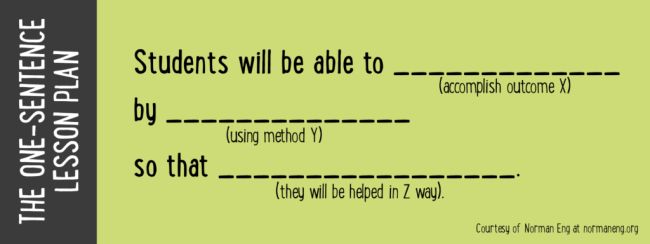
Norman Eng/Introducing the One-Sentence Lesson Plan via CultofPedagogy.com
This kind of lesson planning isn’t for everyone, but the extreme simplicity works well for some. Describe what students will learn, how they will learn it, and how they’ll demonstrate their knowledge.
Learn more: Cult of Pedagogy
Need more help with lesson planning? Come ask for ideas on the WeAreTeachers HELPLINE group on Facebook !
Plus, check out 40 ways to make time for more creativity in your lesson plans ..
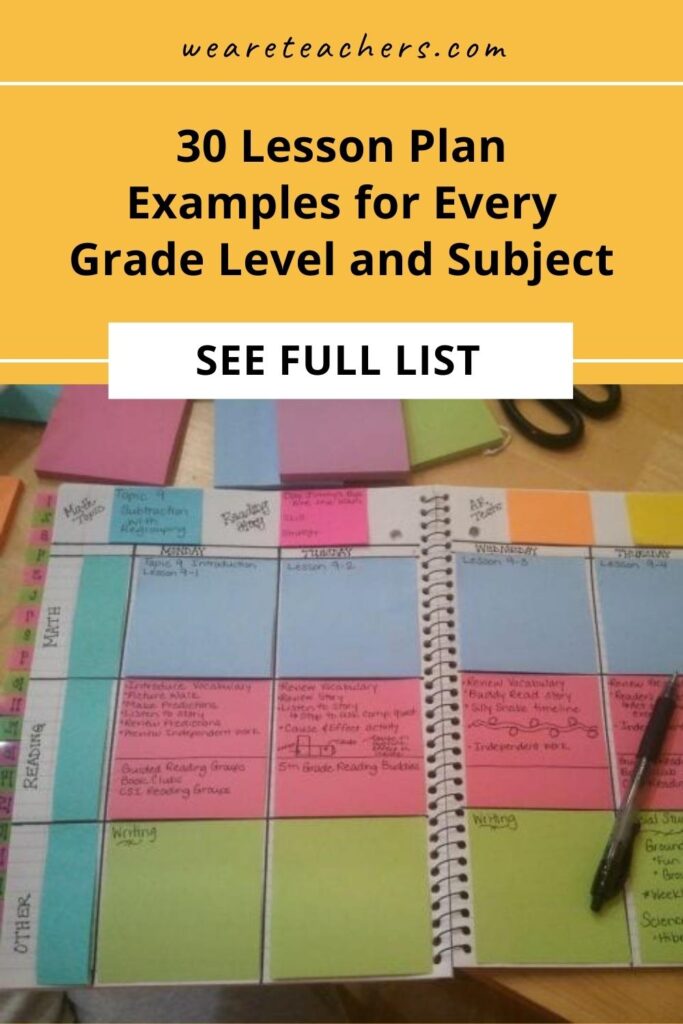
WeAreTeachers
You Might Also Like
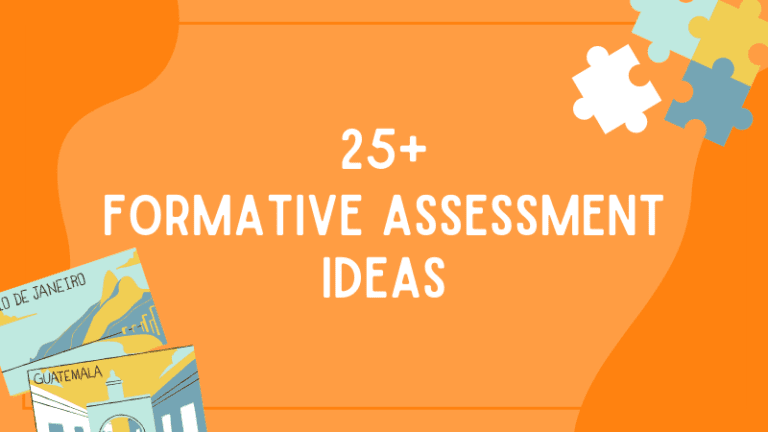
25 Formative Assessment Options Your Students Will Actually Enjoy
Get them excited to show you what they know! Continue Reading
Copyright © 2024. All rights reserved. 5335 Gate Parkway, Jacksonville, FL 32256
We use essential cookies to make Venngage work. By clicking “Accept All Cookies”, you agree to the storing of cookies on your device to enhance site navigation, analyze site usage, and assist in our marketing efforts.
Manage Cookies
Cookies and similar technologies collect certain information about how you’re using our website. Some of them are essential, and without them you wouldn’t be able to use Venngage. But others are optional, and you get to choose whether we use them or not.
Strictly Necessary Cookies
These cookies are always on, as they’re essential for making Venngage work, and making it safe. Without these cookies, services you’ve asked for can’t be provided.
Show cookie providers
- Google Login
Functionality Cookies
These cookies help us provide enhanced functionality and personalisation, and remember your settings. They may be set by us or by third party providers.
Performance Cookies
These cookies help us analyze how many people are using Venngage, where they come from and how they're using it. If you opt out of these cookies, we can’t get feedback to make Venngage better for you and all our users.
- Google Analytics
Targeting Cookies
These cookies are set by our advertising partners to track your activity and show you relevant Venngage ads on other sites as you browse the internet.
- Google Tag Manager
- Infographics
- Daily Infographics
- Template Lists
- Graphic Design
- Graphs and Charts
- Data Visualization
- Human Resources
- Beginner Guides
Blog Education
27+ Easy-to-Edit Lesson Plan Examples [+ Writing Tips]
By Alice Corner , Dec 07, 2023

Lesson plans are the best way to deliver an effective and engaging lesson. Lesson plans also help keep you on track to ensure that your learners hit their goals and targets, in line with your course curriculum.
But sometimes in the high-pressure world of education, it can be difficult to find the time to create inspiring lesson plans on your own.
I’ve gathered together 28 of the best lesson plan examples on the internet that you can use to ensure your lessons are insightful and inspiring.
Table of contents (click to jump ahead):
What is a lesson plan?
What is included in a lesson plan, how to write a lesson plan, preschool lesson plan examples, math lesson plan examples.
- Science lesson plan examples
1. Objectives: know your destination
When writing a lesson plan, start by outlining the learning objectives—what you want your students to take from the session and work backward. Having clear and specific goals helps you plan activities for a successful lesson.
2. Welcome to the hook: make ’em want to learn
Start with an engaging “hook” to capture your students’ attention and make them eager to learn more. This could be a thought-provoking question, an interesting fact, or a surprising tidbit.
Apply a top-down method: plan on a course level the lessons you’re going to include and then go deeper and think about the activities you would like to include in each lesson.
3. Step-by-step: outlining the activities
Now that your students are hooked, it’s time to get down to business. Work on exercises or projects you would like your students to take on. These should serve two important purposes: allowing your students to apply the knowledge they learn in class and allowing you, the teacher, to assess students’ understanding of the materials.
This might include direct instruction (i.e., when you teach the material), guided practice (working together as a class), independent practice (students work on their own) and group activities. Think about the best way to engage students and make sure you include a variety of these activities besides just tests or exams, like quizzes, group discussions, group projects and so on.
Example: If your objective is teaching persuasive writing, your steps might look like this:
- Explanation of persuasive writing techniques and purpose
- Guided practice: analyzing persuasive texts as a class
- Independent practice: having students create a persuasive argument on a given topic
- Group activity: Debating the different arguments in teams
Remember the old adage: “Tell me, and I forget. Teach me, and I remember. Involve me, and I learn.”
4. Check for understanding: keep ’em on track
It’s not uncommon for students to zone out (we’ve all been there), so it’s crucial to regularly check if they’re on track. This means asking questions throughout the lesson and encouraging your students to reflect on the material.
Once you’ve got all these noted down, you can start arranging all the lessons and activities in a meaningful and logical order as well. This applies to the activities within a single lesson too. Answer these questions:
- How much time do you have for the whole lesson?
- What do you plan to start and end the lesson with?
- How much time do you have for each activity?
- If you still have time after all the activities are done, what are you planning to do?
- If you run out of time, what activities are you planning to drop?
As you plan your lesson, keep in mind that not all students learn at the same pace and in the same way. Tailor your activities and materials to accommodate different learning styles, skill levels and interests. This could mean offering choice in assignments, providing extra support for struggling learners, or challenging high-achievers with extended tasks.
Creating a preschool lesson plan involves careful consideration of the developmental needs and interests of young children. Shaping young minds is a rewarding experience, but it can sometimes feel like juggling too many balls at once.
With so many different essential key skills to teach, using a thorough Preschool lesson plan is important for making sure that your learners progress stays on track.
Break your Preschool lesson plans into learning sections
Preschool curriculums can be complex, covering multiple areas of crucial childhood development.
Help visualize each of these areas in their own right by creating a preschool lesson plan that takes a broad overview.
By breaking your lesson plan into learning sections, like this Preschool lesson plan example, you can get a glance at all elements of your students learning at once.
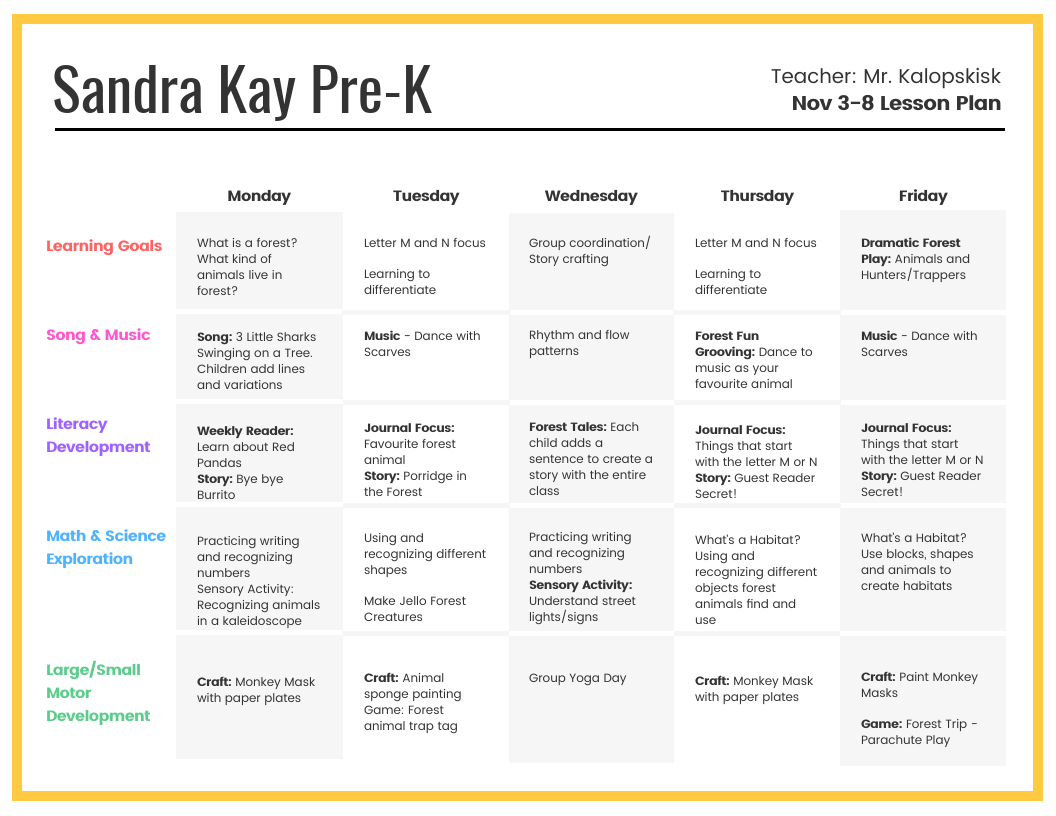
Get an overview of your week with a weekly lesson plan
A weekly lesson plan works great for preschool education planning, as it helps you identify and build lessons around common themes or goals. In the lesson plan template below, weeks have been broken down into different areas of focus.

Use icons in your Preschool lesson plan
Using icons is a great way to communicate visually. Icons are easy to understand, especially when you’re skimming a document.
Take this lesson plan template for example, not only do the icons help communicate the lesson themes, they also make the lesson plan example super engaging and fun.
Using icons can also be a great way to help students who struggle with non-visual learning. For more ways to improve your lesson accessibility, check out this guide to creating a Color Blind Friendly Palette .
Creating a math lesson plan involves careful planning and consideration of various elements to ensure effective teaching and learning. Check out these lesson plan ideas for writing the best math lesson plan, as well as some templates you can edit.
Use pops of color in your lesson plans
Just because your lesson plan tackles a complex subject doesn’t mean it has to be boring. In this lesson plan example a mint green color has been used to help break up the design. You could color code different subjects or units if you have multiple classes to teach.
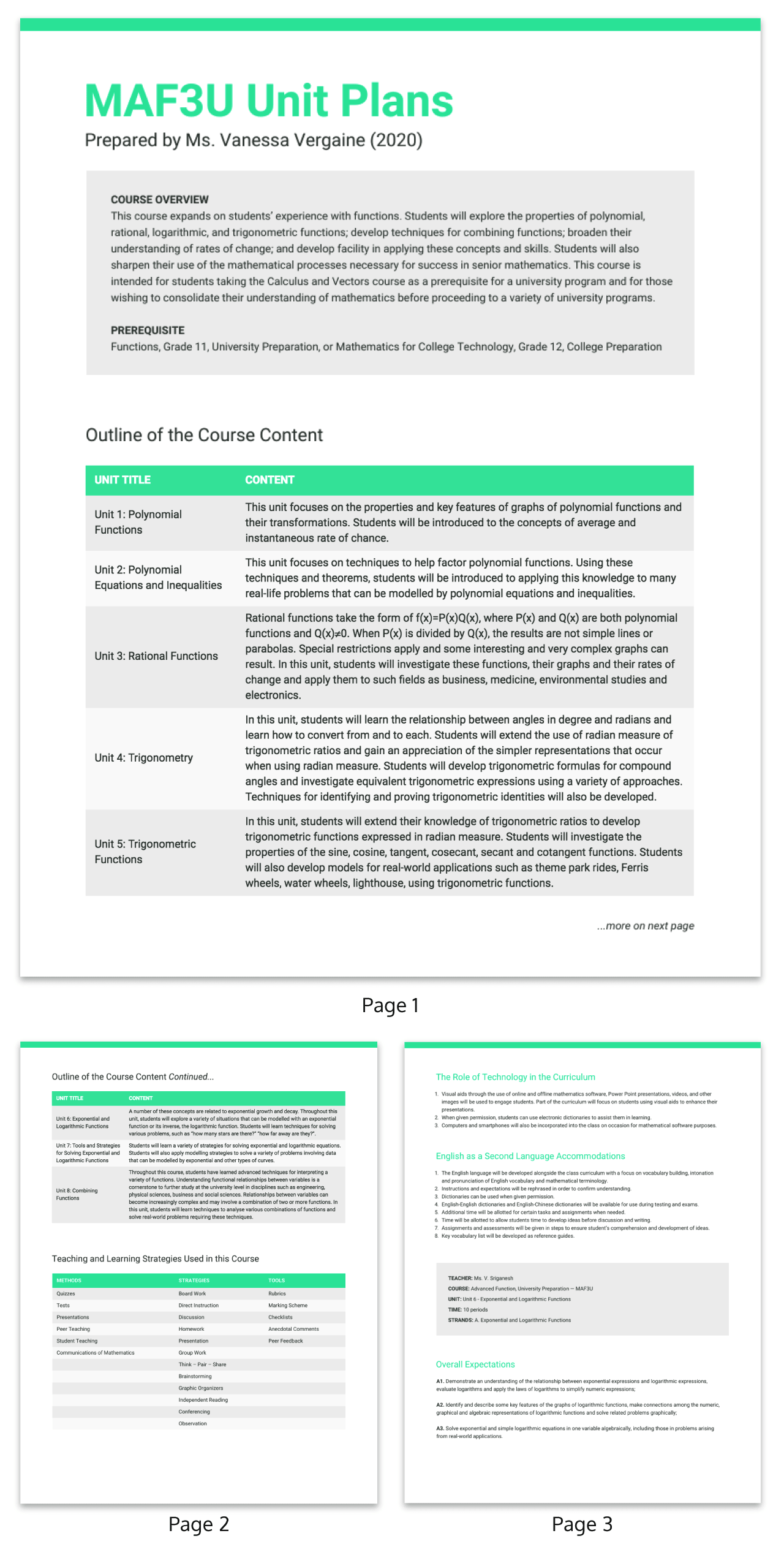
Break your lesson plan into sections to make it easy to follow
Being properly prepared for any eventuality in your lesson starts with good planning. By using sections, like in the lesson plan example below, you can cover all of your bases.
When lesson planning, consider the following:
- Lesson discussion questions
- Activity options for multiple group sizes
- Lesson notes or feedback
In this math lesson plan activity, the teacher has thought through all of the needs of their class.

Think outside the box when lesson planning
When lesson planning, the world, or at least the internet, is your Oyster. Instead of just teaching vocabulary, use scavenger hunts, word searches, or story activities.
Try picking a new activity and building your lesson around that. In the lesson activity example below, Merriam-Webster has a dictionary scavenger hunt that will keep students engaged and entertained throughout your English lesson.

Highlight your lesson objectives at the top of your lesson plan
Your learning objectives should guide your lesson planning, not the other way around.
In this sample lesson plan that focuses on analyzing a film for an English class, the learning objectives are housed within the same section as the lesson plan overview, right on the first page:

If you want to learn how to write an actional learning objective , check out this post on learning objective examples .
Science l esson plan examples
Planning a science lesson can mean anything from experiments to monitoring or diagramming and labelling.
Following a template, like in the science lesson plan examples below, can help make sure that your science lessons run smoothly.
Provide a space for reflection in your science lesson plan
Whilst a lesson plan is a place to schedule your activities, it can also be a great document to refer back to when planning future sessions. Adding a reflection section in your science lesson plan can be a great way to add notes about what worked and what didn’t within your lesson, for future reference.

Break projects down into sections of deliverables
If you’re conducting a difficult lesson, such as a hands-on science project, it can be handy to help yourself and your students by outlining expectations. A checklist can be a great way to make your science lesson plan as effective as possible.
In this lesson plan example, the deliverables have been broken into easy-to-follow checklists.

Use illustrations to bring your lesson plan templates to life
Your lesson plans should inspire you, not bore you! Using illustrations is a great way to bring your lesson plans to life.
In this sample lesson plan, the teacher has used colorful and playful illustrations to reflect the content of the lessons.

When creating Elementary school lesson plans, you need to make sure that you’re keeping a good overview of many different subjects at once.
Having a clear, easy to understand Elementary lesson plan, like in the examples below, is really important for making sure that all your learning objectives are being met.
Break your elementary lesson plans into day and subject sections
Elementary students will often be studying various topics and subjects at once and keeping an overview of this can be difficult. By creating a weekly lesson plan you can make sure that your students stay on track.
In this lesson plan template, subjects and activity have been split across the days, with simple summaries of each section within the lesson plan.

Include notes sections in your lesson plans
Planning a lesson is important, but reflecting on a lesson is essential. Adding notes sections to your lesson plans, like in this weekly lesson plan example, is a great way to remind yourself to evaluate as you go.
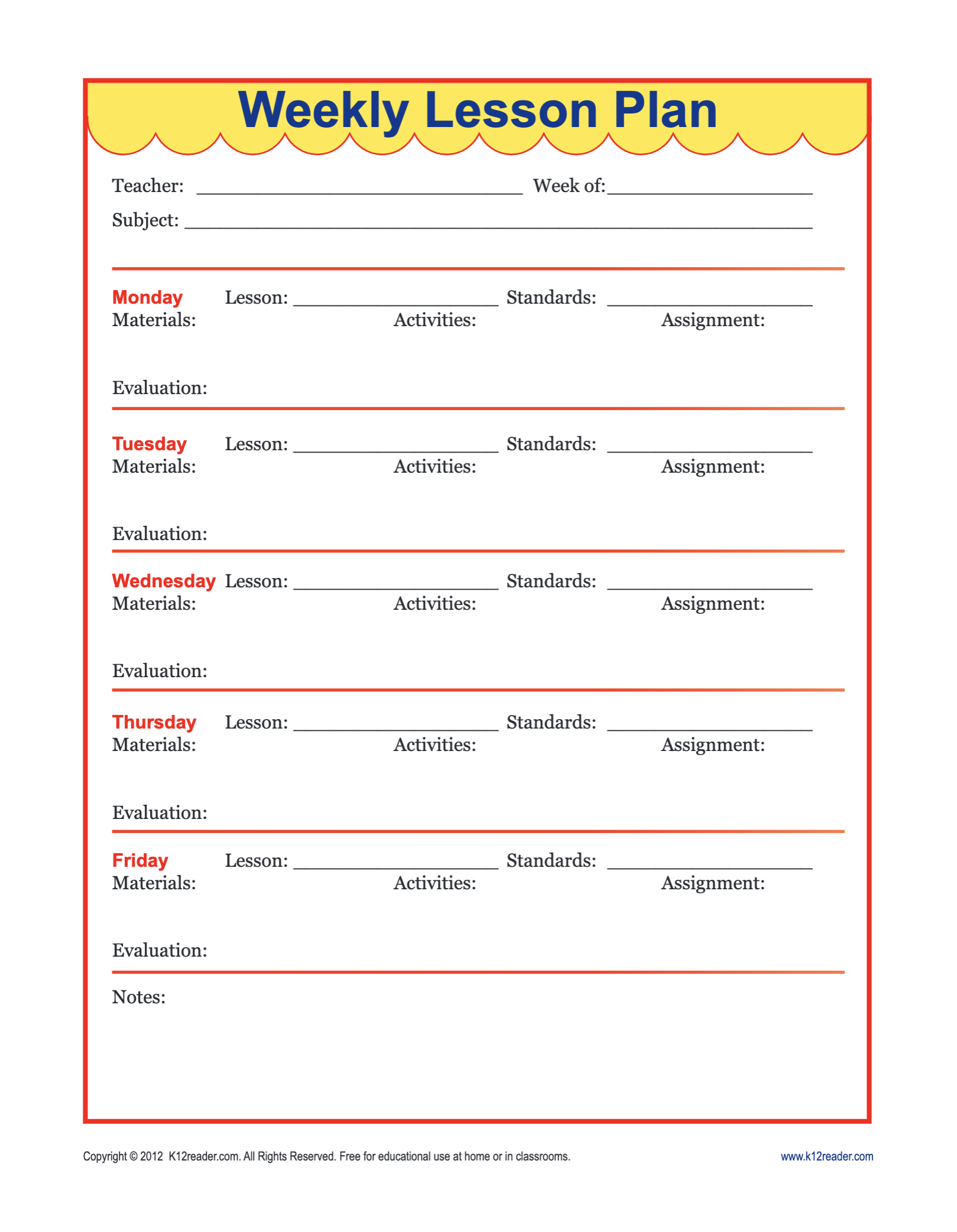
Evaluating yourself and your lessons can be a daunting task. Applying various evaluation strategies, such as a SWOT Analysis , is an easy way to give your evaluations focus.
Creating a high school lesson plan involves a more structured approach, as students at this level are typically engaged in more advanced academic subjects.
Ensuring that your High School lesson plans account for success and reinforcing skills is one way to deliver the best education for your learners.
Include indicators of skill in your high school lesson plans
In high school, lesson plans tend to be more advanced. In the high school lesson plan example below, the teacher has included a section for indicators of skill.
Indicators of skill are a great way to measure your students’ understanding of a topic and can be used to help inform your planning and teaching. Add two or three skill indicators into your lesson plans to ensure you know how to identify which students may need additional support from you in teaching.

You can also scroll back to the Math lesson plans section for more ideas on high school lesson plan templates.
Remember how I mentioned you should include timelines in your lesson plan? Well, for a high school lesson plan, you can include a timeline template like this one to make sure your students understand all the dates required for their school project:

When creating art lesson plans, use bright colors, patterns, icons and graphics to create a truly engaging visual art lesson plan, like in the examples below.
Art lessons lend themselves to creative and visual learning , so your Art lesson plans should be creative and visual as well.
Incorporate learning examples in your art lesson plans
Art lesson plans can be one of the most fun to create. Art as a visual medium lends itself to an exciting and decorative lesson plan.
In the art lesson plan example below, the teacher has inserted visual examples to use during the lesson directly into their lesson plan. Collecting all of this information in one place means that you can quickly refer back to your lesson plan mid teaching.

Be creative with your art lesson plan design
If you’re creating an art course, you’re probably a creative person. Why not let that creativity shine in your lesson plan templates?
Fun illustrations and patterns have been used in the lesson plan sample below to create a visually appealing lesson plan design.

When picking colors for your lesson plan design, some schools will need to be aware of color connotations. Certain colors should be avoided due to gang or rivalry associations. Some schools will also want to ensure that all materials produced fit within your school colors.
Use colors and patterns in your art lesson plan designs
As well as colors, patterns can be used, like in this art lesson plan example, to create interest in your lesson plan design.
Picking a patterned but simple background is an easy way to add depth to any lesson plan design.

When creating middle school lesson plans, like in the templates and examples below, it’s important to focus on success and simplicity.
Middle school is a time for make or break for many learners. Skills that they learn in middle school carry them through life and it can be a huge weight to carry. But teaching middle school can also be incredibly rewarding. Here are some tips to help you create an effective middle school lesson plan:
Make note of what success looks like in your lesson plan
In teaching, quite often the end goal is not for the students to just arrive at the correct answer, but to understand the process of getting there. Having this mentality in your mind whilst lesson planning is an excellent way to ensure your students are learning effectively and that you are maximizing your teaching impact.
Add a section to your lesson plans as to what success looks like for you and your students like in the Middle School lesson plan template:

Color code your lesson plan for ease of use
Colors can be a great differentiator in content and color-coding your lesson plans is a great way to make information pop. In this lesson plan example, each day has a different color which makes planning and evaluating much easier.

Related Reading: What Disney Villains Can Tell Us About Color Psychology
Creating simple lesson plans involves breaking down the content into manageable components and incorporating straightforward activities.
Sometimes simple is best—especially when it comes to lesson planning. When you’re panicked mid-teaching, having a simple and straightforward lesson plan that you can take a quick glance at it can be invaluable.
Keep your lesson plan simple for stressful situations
When performing under pressure, staying simple is usually the best option. Using a clean and modern lesson plan design is one way to ensure that you can stay focused on what matters: teaching.
Simple doesn’t have to mean boring, though. Using good design principles and following one or two graphic design trends means that your simple lesson plan template can still look smart.

Use an icon to help differentiate different subject lesson plans
Icons are an easy way to differentiate your lesson plans by subject or topic. In the lesson plan example below, a large book icon has been used at the top of the page so that you can quickly see that this is an English lesson plan.
You could use an icon for each subject you teach, or use icons to tell a story . You could even replace the icon with a photo of your lesson materials!

Use an action plan approach in your lesson planning
In the simple lesson plan example, the tasks in the lesson plan have been labeled as an “action plan” . By keeping the lesson plan design simple, the focus is really on the content of the lesson plan.
Creating an action plan when teaching your lessons is a great mindset for creating engaging lessons and proactive teaching.
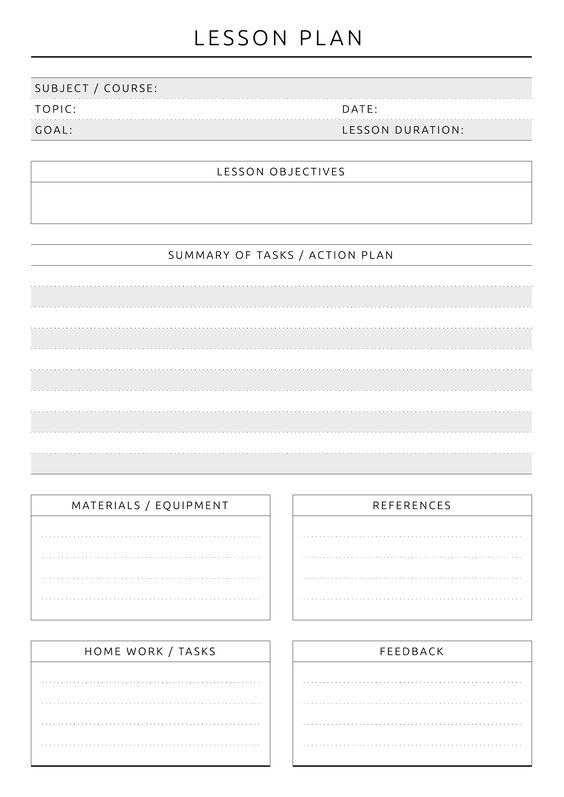
Creating an English lesson plan is the best way to keep track of all the learning strands and activities that are needed for learning success.
Imagination, drama, romance and tragedy. English lessons have it all. But they can also be complicated to teach, with many moving parts to any one lesson.
Like you’ll see in the English lesson plan examples below, creating engaging activities to a strict time schedule is perfectly possible with enough planning.
Use your lesson plan to schedule each activity by the minute
Any teacher will know the feeling of reaching the end of your material with 10 minutes left in the lesson.
Avoid running short (or running over!) in your lessons by planning down to the minute. The English lesson plan example below measures out timings for each activity so you finish perfectly on time.
You can use a timer on your interactive whiteboard , or get students to time themselves. Scheduling is a great skill to incorporate into any lesson plan.

Creating a history lesson plan is essential for a successful session no matter if you’re teaching the near past or the ancient history.
Using common teaching resources such as timeline infographics , or imaginative play and learning are exciting ways to make your History lesson plans exciting.
Prepare for history lessons with a history timeline infographic
Teaching history effectively and engagingly relies on the teacher’s ability to bring the past back to life. For some students, mentally visualizing history can be difficult. A timeline infographic is a great way to teach historical events.
When planning your history lesson, make sure you have all of your timelines sorted. You can either prepare your history timelines in advance or get the students to create their own history timeline as part of the lesson activity.
Venngage has a whole range of timeline infographic templates that are easy to customize.

Want to learn more about how to create a timeline infographic ? Check out the video below:
Use themes and historical events to enrich your lesson planning
When planning your history lessons, look for topical themes or historical events that you can anchor your lesson plan around.
In the lesson plan example below, the teacher is using Black History Month as an anchor point for their students’ learning.

Teaching the historical significance of Black History Monthand engaging students in related learning activities throughout February is a great way to contextualize current affairs. There are plenty of resources online to help create your Black History Month lesson plans.
Related Reading: Looking for other global holidays and events to theme your lessons on? Check this Ultimate List of Holidays .
Creating a kindergarten lesson plan involves similar principles to those used for preschoolers but with a bit more structure and focus on foundational academic skills.
We all know that meme “teaching kindergarten is like using a blender without a lid”. Staying organized is super important and having thorough easy-to-follow kindergarten lesson plans is one way to make sure your teaching stays on track.
Use themes to help plan your Kindergarten lessons
Help your kindergarteners embrace learning by using themes to plan their education. Themes are a great way to work through lots of different learning activities under one thematic umbrella.
This kindergarten lesson plan example uses St Patrick’s Day as its thematic anchor and bases Math, Art, Science and more off of one common theme.
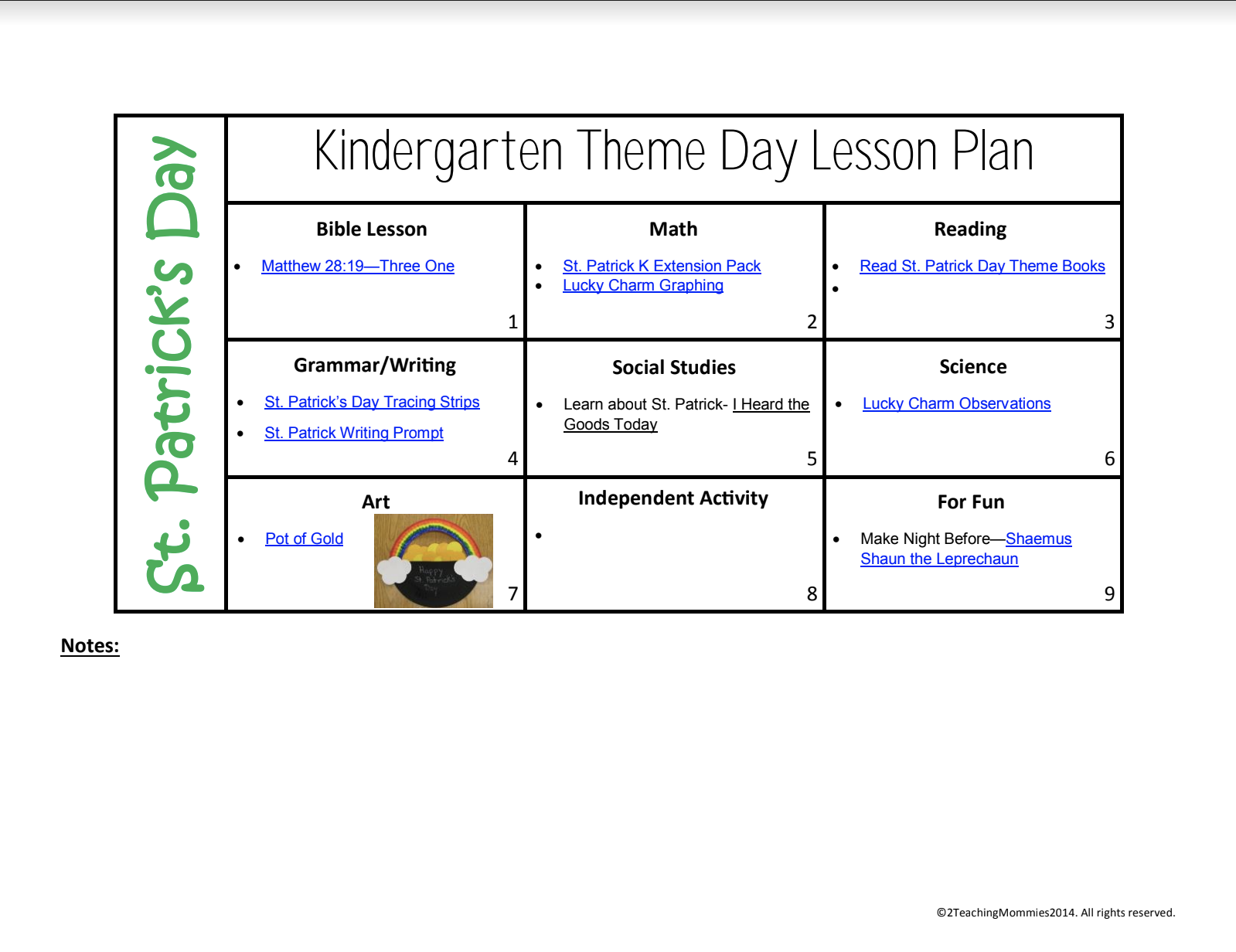
Make your lesson plans easy to skim
We’ve all been in a spot when our mind goes blank and we need to quickly refer back to our lesson plan. Especially if you’re interviewing or teaching in front of others.
By making your lesson plans easy to skim, you can quickly regain your train of thought and continue conducting a successful lesson.
In the sample lesson plan below the teacher has used simple blocks, checklists and icons to help ensure their lesson plan is easy to understand at a glance.

When creating eLearning , distance learning, remote learning, digital learning lesson plans—basically, anything outside the usual classroom setup—always be ready for its own set of unique challenges.
Engaging learners from behind a screen, or creating lessons that can exist outside of a traditional classroom environment can be difficult. But proper eLearning lesson plans can help you navigate non-traditional learning environments.
Break your eLearning lesson plan into activities or subjects
With so many people shifting to remote or digital learning keeping track of all of your separate subjects can be difficult. Creating an eLearning lesson plan that is broken into smaller chunks, with space for each topic, is an easy way to keep learning on track.
In this eLearning lesson plan example subjects are color coded and broken into small blocks.

For more examples of eLearning lesson plans, check out this post on course design templates .
Looking for more eLearning resources?
- 7 Ways to use eLearning Infographics
- Digital Learning Communication Resources
- What is an Infographic?
- 10 Types of Visual Aids for Learning
Use a daily schedule when learning remotely
Learning remotely can be a big change for both teachers and students. One way to keep your learning on track is with an easy-to-follow daily schedule. Using a daily schedule as a lesson plan, like in the example below, is one way to maintain a routine during difficult times.

As well as scheduling within your lesson plan, you can also create a calendar to help keep your students on track.
Allow time for creativity and fun in your lesson plans
One of the biggest benefits of eLearning, Remote Learning and Digital Learning is that you can stray from the confines of a traditional classroom.
Giving students the opportunity to explore topics creatively can be one way to engage your learners in difficult times. Every student will have a different learning style and by scheduling structured creative learning activities you can ensure that your entire class has the opportunity to thrive.
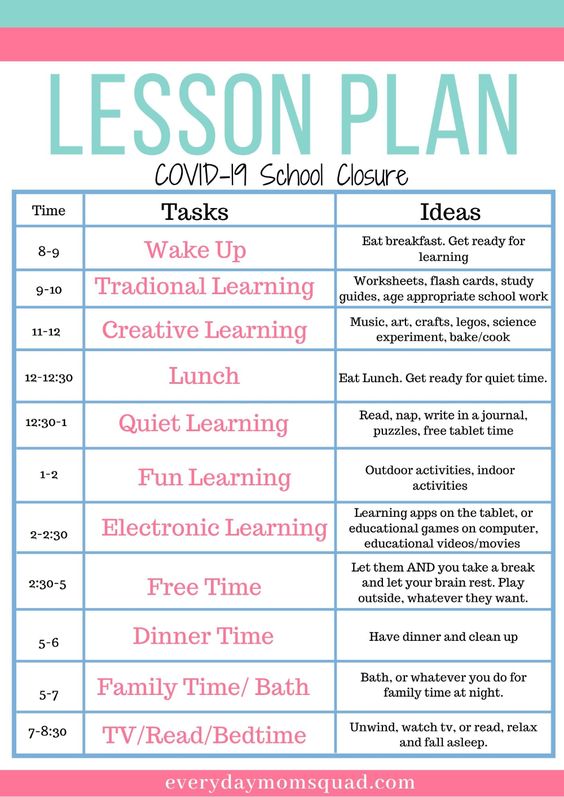
To sum up: Use a lesson plan template to write an actionable and easy-to-follow lesson plan
Writing a lesson plan from scratch can be difficult, which is why Venngage has created tons of lesson plan templates you can edit easily. You can also draw inspiration from the different lesson plan examples in this post to customize your lesson plan template.
Simply create a Venngage account, pick the template you want and begin editing. It’s free to get started.
You are using an outdated browser. Please upgrade your browser or activate Google Chrome Frame to improve your experience.

Creating PPP Lesson Plans: How to Teach ESL Effectively Using Presentation, Practice and Production
Want your students to be enthused, energetic learners?
Here’s a secret: It’s all in the lesson plan.
Using the PPP structure for your lessons will help you stay on track, deliver new material effectively and most importantly, help your students build new English skills.
PPP is a lesson plan template that consists of Presentation (P1), Practice (P2) and Production (P3) , and it’s often used for ESL (English as a Second Language) classes. It focuses on giving students a solid foundation for new concepts, then encouraging them to apply these on their own.
Read on to find out how to deliver awesome ESL lessons with the PPP template!
What Makes an ESL Lesson Plan Exceptional?
How to make esl lesson plans with a ppp template, 1. presentation, 2. practice, 3. production.
Download: This blog post is available as a convenient and portable PDF that you can take anywhere. Click here to get a copy. (Download)
- Clear aims and objectives. First off, make sure you have a good understanding of your main goal for the lesson and how you propose to reach that goal. It’s also a great idea to share these with your students so they’ll know exactly what they will accomplish.
- Grading. Careful, we’re not talking about correcting work and giving letter grades here! This is the concept of climbing a hill, starting off with something easy or relatable to your students and then making the material more challenging as you ascend.
- PPP structure. This is one of the most used lesson plan formats in ESL. PPP (presentation, practice, production) allows you to develop a structured, graded and time-efficient lesson plan that conveys the material in an understandable way.
- Effective time breakdown. Knowing when you should talk and when you should allow your students to engage is another key component. One strategy is jotting down time limits for each activity in the margins of the lesson plan sheet. For the PPP structure, a good time allotment might be 15 minutes of Presentation (P1), 20 minutes of practice (P2) and 25 minutes of production (P3).
- Relevant material. Take a few moments to gauge your student’s level, their interests, hobbies, work and home life. Consider showing videos, trending articles and other native content that your students would enjoy. For instance, FluentU features English videos like movie trailers and TV series clips, with interactive subtitles and transcripts for learners.
Let’s go through each step of the PPP template:

Presentation is the first step, and it’s also the most important. This is your time to shine because it’s the main part of teaching : you’ll be explaining new concepts to your eager students.
At this stage, teachers should talk approximately 75% of the time.
Make your lesson exciting and relatable
Remember how boring it was when you had a teacher who only lectured, with little enthusiasm? Well, don’t be that teacher—break the mold and become animated. Students learn through context, so tell a story or use resources that excite students to learn more. Peaking interest is essential.
To lead students into the lesson, you can start with something familiar, such as material discussed in a previous class. For example, if you’re talking about house vocabulary, focus on the bedroom first, then break down the vocabulary inside of the bedroom.
Show visuals like photos and videos
Use visuals to stimulate understanding and get your students curious about a topic.
If you are presenting key places in a city or town, using pictures of your students’ town/s will invoke interest and be relevant to their world.
For teaching home-related vocabulary, you can display photos from your home, relating them to relevant vocabulary. After that, show your students how to use vocabulary nouns with prepositions of place through statements like “The toaster is on the counter.”
Ask thoughtful questions
Once introduction is complete, you can then guide your students to analyze the material more closely. You are still in control of your classroom so keep presenting, but ask questions and make your students think more about what it is they are seeing and hearing.
Questions are also great for checking if students understand the new material. Don’t let them off the hook so easily. Try not to tell them answers, allowing them to work it out in English!
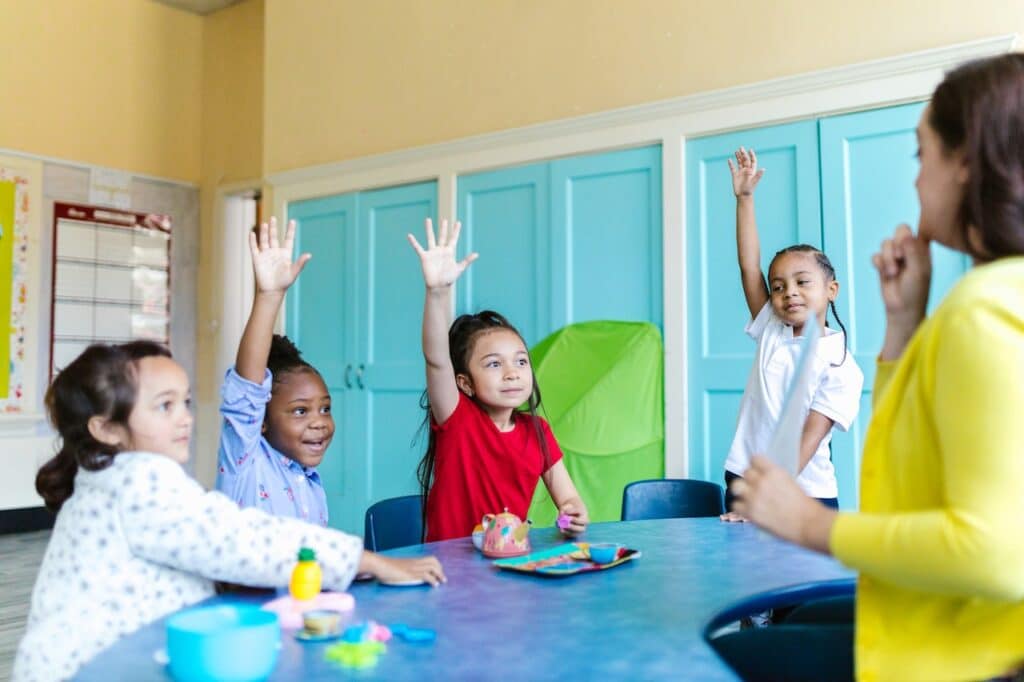
Practice is the second stage of the PPP lesson plan template. This is when you will hand over a bit of control to your students and let them try out the new material themselves. If your presentation was well-developed and awesome, your students will be more than ready to jump in.
In this stage, you will give your students a set of tasks or activities . These tasks should be challenging and only solvable with the new material, but not too difficult.
The students will do most of the talking since they’ll be going over the material with you and their classmates. Generally, you can aim to let your students speak 65% of the time and just jump in every now and then to point out something new or answer questions.
Guide your class through exercises
For a smooth transition into the practice stage, do exercises together with your students first, or work through questions together.
To continue with the same example of rooms in a house, a great practice activity would be to let your students label nouns and prepositions of place around the room. There are many techniques for this, and you can go around the room looking out for trouble areas and helping out as needed.
Do pair and group practice
Once your students get more used to the material, you can begin pair and group activities.
Allowing students to brainstorm and work together will encourage them to communicate more and learn about their classmates. For groupwork, you can even divide the class and organize a contest to make them more eager to focus on the material.

Production is the final stage in a PPP lesson plan. This is also referred to as the fluency stage—your students will now be like birds leaving the nest for the first time.
In the production stage, teacher talk time is at its lowest and almost nonexistent. Let your students be creative and develop their own work , speaking 90% of the time to your meager 10%. It’s important for them to gain confidence in English on their own.
Set up writing or speaking activities
Most production activities involve writing or speaking, and sometimes both are combined if necessary. This allows your students to build confidence and be creative when using the new material, as it’s solely in their hands.
Carrying our example house vocabulary lesson through the final step, you can now let your students craft a short story or presentation involving the many things they have in their own home. They can write a script and present it to the class during production.
Encourage production through groupwork
Similar to the previous stage, you can separate your class into pairs or groups for production. They can construct dialogues, monologues, scripted plays and so on together.
One great pair exercise you can use is to have two students create a script using the new material and then let them act it out in front of the class.
A great, fun and material-rich lesson will keep your students encouraged to learn more and build their confidence as English speakers.
So for lesson plan success, be sure to construct a well-developed and exciting lesson plan using the PPP template. Good luck, and enjoy!
Enter your e-mail address to get your free PDF!
We hate SPAM and promise to keep your email address safe

- Professional development
- Planning lessons and courses
Student presentations
In this article I would like to give you a few tips and some advice on what I've learned from helping students prepare and deliver presentations.

- Why I get students to do presentations
- Syllabus fit
- Planning a presentation lesson
- Classroom Management
Why I get students to do presentations Presentations are a great way to have students practise all language systems areas (vocabulary, grammar, discourse and phonology) and skills (speaking, reading, writing and listening). They also build confidence, and presenting is a skill that most people will need in the world of work. I find that students who are good presenters are better communicators all round, since they are able to structure and express their ideas clearly.
- Presentation skills are extremely useful both in and outside the classroom. After completing a project, a presentation is a channel for students to share with others what they have learned. It is also a chance to challenge and expand on their understanding of the topic by having others ask questions. And in the world of work, a confident presenter is able to inform and persuade colleagues effectively.
- Presentations can also form a natural part of task based learning. By focussing on a particular language point or skill, the presentation is a very practical way to revise and extend book, pair and group work. The audience can also be set a task, for example, a set of questions to answer on the presentation, which is a way of getting students to listen to each other.
Syllabus fit Normally the presentation will come towards the end of a lesson or series of lessons that focus on a particular language or skill area. It is a type of freer practice. This is because the students need to feel relatively confident about what they are doing before they stand up and do it in front of other people. If I have been teaching the past simple plus time phrases to tell a story, for example, I give my students plenty of controlled and semi controlled practice activities, such as gapfills, drills and information swaps before I ask them to present on, say, an important event in their country's history, which involves much freer use of the target grammar point.
Planning a presentation lesson Normally a presentation lesson will have an outline like this:
- Revision of key language areas
- Example presentation, which could be from a textbook or given by the teacher
- Students are given a transcript or outline of the presentation
- Students identify key stages of the example presentation – greeting, introduction, main points in order of importance, conclusion
- Focus on linking and signalling words ('Next…', 'Now I'd like you to look at…', etc.). Students underline these in the transcript/place them in the correct order
- Students are put into small groups and write down aims
- Students then write down key points which they order, as in the example
- Students decide who is going to say what and how
- Students prepare visuals (keep the time for this limited as too many visuals become distracting)
- Students practise at their tables
- Students deliver the presentations in front of the class, with the audience having an observation task to complete (see 'Assessment' below)
- The teacher takes notes for feedback later
It is important that the students plan and deliver the presentations in groups at first, unless they are extremely confident and/or fluent. This is because:
- Shy students cannot present alone
- Students can support each other before, during and after the presentation
- Getting ready for the presentation is a practice task in itself
- When you have a large class, it takes a very long time for everyone to present individually!
I find it's a good idea to spend time training students in setting clear aims. It is also important that as teachers we think clearly about why we are asking students to present.
Aims Presentations normally have one or more of the following aims:
- To inform/ raise awareness of an important issue
- To persuade people to do something
- Form part of an exam, demonstrating public speaking/presentation skills in a first or second language
I set students a task where they answer these questions:
- Why are you making the presentation?
- What do you want people to learn?
- How are you going to make it interesting?
Let's say I want to tell people about volcanoes. I want people to know about why volcanoes form and why they erupt. This would be an informative/awareness-raising presentation. So by the end, everyone should know something new about volcanoes, and they should be able to tell others about them. My plan might look like this:
- Introduction - what is a volcano? (2 minutes)
- Types of volcano (5 minutes)
- Volcanoes around the world (2 minutes)
- My favourite volcano (2 minutes)
- Conclusion (2-3 minutes)
- Questions (2 minutes)
Classroom Management I find that presentation lessons pass very quickly, due the large amount of preparation involved. With a class of 20 students, it will probably take at least 3 hours. With feedback and follow-up tasks, it can last even longer. I try to put students into groups of 3 or 4 with classes of up to 20 students, and larger groups of 5 or 6 with classes up to 40. If you have a class larger than 40, it would be a good idea to do the presentation in a hall or even outside.
Classroom management can become difficult during a presentations lesson, especially during the final presenting stage, as the presenters are partly responsible for managing the class! There are a few points I find effective here:
- Training students to stand near people who are chatting and talk 'through' the chatter, by demonstration
- Training students to stop talking if chatter continues, again by demonstration
- Asking for the audience's attention ('Can I have your attention please?')
- Setting the audience an observation task, which is also assessed by the teacher
- Limiting the amount of time spent preparing visuals
- Arranging furniture so everyone is facing the front
Most of these points are self-explanatory, but I will cover the observation task in more detail in the next section, which deals with assessment.
Assessment The teacher needs to carefully consider the assessment criteria, so that s/he can give meaningful feedback. I usually run through a checklist that covers:
- Level - I can't expect Elementary students to use a wide range of tenses or vocabulary, for example, but I'd expect Advanced students to have clear pronunciation and to use a wide range of vocabulary and grammar
- Age - Younger learners do not (normally) have the maturity or general knowledge of adults, and the teacher's expectations need to reflect this
- Needs - What kind of students are they? Business English students need to have much more sophisticated communication skills than others. Students who are preparing for an exam need to practise the skills that will be assessed in the exam.
I write a list of language related points I'm looking for. This covers:
- Range / accuracy of vocabulary
- Range / accuracy of grammar
- Presentation / discourse management- is it well structured? What linking words are used and how?
- Use of visuals- Do they help or hinder the presentation?
- Paralinguistic features
'Paralinguistics' refers to non-verbal communication. This is important in a presentation because eye contact, directing your voice to all parts of the room, using pitch and tone to keep attention and so on are all part of engaging an audience.
I find it's a good idea to let students in on the assessment process by setting them a peer observation task. The simplest way to do this is to write a checklist that relates to the aims of the lesson. A task for presentations on major historical events might have a checklist like this:
- Does the presenter greet the audience? YES/NO
- Does the presenter use the past tense? YES/NO
And so on. This normally helps me to keep all members of the audience awake. To be really sure, though, I include a question that involves personal response to the presentation such as 'What did you like about this presentation and why?'. If working with young learners, it's a good idea to tell them you will look at their answers to the observation task. Otherwise they might simply tick random answers!
Conclusion Presentations are a great way to practise a wide range of skills and to build the general confidence of your students. Due to problems with timing, I would recommend one lesson per term, building confidence bit by bit throughout the year. In a school curriculum this leaves time to get through the core syllabus and prepare for exams.
Presentations - Adult students
- Log in or register to post comments
Presentation Article
Research and insight
Browse fascinating case studies, research papers, publications and books by researchers and ELT experts from around the world.
See our publications, research and insight
Create Your Course
How to build a lesson plan (+ templates), share this article.
So you’ve got a great course topic , you’ve built a course outline to help you deliver, and now you’re all set to start your first lesson plan.
When it comes to building an online course that delivers, you need to be strategic about your lessons. Each lesson plan is a building block that ladders up to your overarching course goals.
Let’s talk about how to build a lesson plan that hits home.
Or grab them here for google docs or word!
Skip ahead:
What does a good lesson plan look like?
5 steps for building a lesson plan from scratch .
A well-designed lesson plan has seven key elements:
Class objectives
Objectives, at a basic level, are what the lesson sets out to achieve — think of them as your North Star. Objectives communicate three key things:
- Why students need the lesson
- What they’ll be able to do at the end of the lesson
- How they’ll demonstrate knowledge.
Say one of the lessons in your social media course is “choosing the right channels.” In that case, your objective could be: At the end of this lesson, students will be able to compare different social media channels and choose the one that best aligns with their content goals.
Teaching and learning are more effective when all the stakeholders understand the purpose of the lesson. When anyone veers off the track, they can easily realign themselves with the North Star.
Hook is what grabs the attention of your students. It is usually a statement surfacing the problem they are having — which is why they signed up for your course in the first place. This is your chance to prove that you understand their problem and can solve it.
Back to our previous example, the hook could be a story about a creator who switched channels and finally got traction on social media after trying for many years. Or you could share data around how social channels affect how much money creators make.
Learning activities
Here, you spell out everything the lesson entails — from class activities and instruction time to independent work time and even assessments. Everyone involved needs to know what the lesson covers so they can prepare ahead of time.
Again, referring to our earlier example, the learning activities might look like this:
- Worksheets
- Instructor-led sessions
- One Q and A session at the end of the class
- Independent work time (which doubles as assessment)
- Class discussions
Learn more: Blended learning and scheduled class activities
Timeline shows the duration of each activity in the lesson. More than showing how long the class will take, assign time limits to the different sessions within each lesson, including assessment, main instruction, breaks, and student participation.
Build in a buffer between each session to take care of any unforeseen issues. Say you want to spend 15 minutes on a class presentation; assign 20 minutes to it instead.
Having a realistic lesson timeline helps you stay on track, making sure you have enough time to cover all the key areas of your lesson.
This is where you highlight what students need to make the most of your class — to set them up for success. The last thing you need is for your course to lose credibility because a particular student wasn’t sufficiently equipped for it.
Maybe they need to complete a foundational course first to bring them up to the level of knowledge required for the lesson. Or they need access to certain tools and equipment. Tell them all about it here.
For a social media class, for instance, students must have active accounts and maybe a certain number of followers.
Closure is how you wrap up the class. It typically involves a recap of the key points covered in the lesson and a quick review of the class objectives.
The instructor might ask reflective questions such as “What was the most challenging part of the lesson for you?” or “What would you like to learn more about in this topic?” Or ask students to create a mind map of the key points covered in the lesson.
At this point, students and instructors can reflect on the lesson activities at the end to see if they met their goals. Students can also ask last-minute questions before the final assessment.
Assessment
This is the parameter for measuring how well a student understands what they’ve learned in a particular lesson. It helps the course instructor assess students fairly.
The assessment can take several forms. One might administer a summative test — like an end-of-class quiz. Or conduct a survey with open-ended questions at intervals to gauge students’ knowledge.
Whichever method you choose, make sure you inform students ahead of time so they prepare adequately for it.
Before you begin
Before you dive into lesson planning, start with a few key questions to determine the goal of your lesson. As the topic expert, the breadth of this course content is clear in your head, but your students are still figuring it out as they go along.
Keep a narrow focus for each lesson while keeping the bigger picture in mind – this will help your students build knowledge in context so they can use it independently and remember it forever!
- What do your students already know? This is back to what you’ve covered in previous lessons or what foundational knowledge you expect students to have. Do they have all the definitions they need to understand today’s topic? Are there any gaps you need to close before you dive in? That will be your starting point for this lesson.
- What do they need to learn today? Eyes on the prize here – keep your goal clear, or you’ll get lost along the way! Set yourself a single goal for this lesson: should students understand the formula for a unique value proposition, or should they be able to write a great cover letter? What single concept or skill do you want this lesson to impart to your students? Remember to keep it simple; if it’s too complex, you might want to consider splitting it into smaller lessons to avoid confusing your students with information overload.
- What’s the best way to lock it into place? Now that you’ve locked down the goal for today’s lesson, you can decide on the best way to deliver the information. Is this something best delivered through video, or is it better explained with text and diagrams? Could you represent this as an infographic? What practice activities would help your students lock in their newly acquired skills?
Related: How to do a training needs assessment
It’s not always about downloading your brain onto the page. You need to consider how you explain things so your students fully understand not only the new facts, but the context surrounding them – that’s the key to them being able to apply these new skills independently when the course is over.
With the Thinkific course builder, you have so many teaching tools and resources at your disposal – use them in harmony with one another to give your students a dynamic learning experience .
Now that you’ve got those three guiding principles in mind, let’s put them to work in your lesson plan.
Set the stage
Begin each new lesson by setting the stage for your students. You can do this in three key steps:
- Take a brief moment to look back at what you covered in the last lesson,
- Give a high-level overview of what today’s lesson will entail, and
- Tell students the key skills or takeaways they will have conquered by the end of the lesson.
In particular, consider if any content from previous lessons is applicable to the new lesson. Never miss an opportunity to name-drop or draw examples from old content while introducing new material! It’s a great opportunity to help your students build context between what might feel like a confusing array of new facts. When you build bridges between old and new knowledge, it creates that lightbulb moment for students to see how all the pieces fit together.
This is more than just summarizing or expectation-setting – it’s a strategic educational principle. By reminding students of previous lessons, you help them draw connections between old and new content so they can understand how everything fits together.
When you share the key touchpoints for today’s lesson, you set up a framework for them to contextualize everything that follows. If they know what the final goal is, they will naturally be more attuned to anything you say about those skills from that point onwards. This brief process at the beginning of each lesson provides anchors for students to shape their understanding throughout the rest of the lesson.
Explain new information
This is the main component of any lesson plan. When it’s time to introduce new content, make sure to do so clearly and simply. Explain new concepts in the most straightforward way possible. Consider your weakest student, and explain things with them in mind – even your strongest students will still benefit from that simplicity!
Be sure to use lots of examples to help students develop context with new information. One tip here is to use a mix of examples that draw from general knowledge and subject-specific knowledge. For example, you can and should give concrete examples grounded in the course subject matter; for more abstract concepts, however, it can be helpful to explain things using everyday examples that everyone can relate to.
Related: The Ultimate List of Free Online Course Lesson Plan Templates
Consider using apples and oranges to explain abstract economic concepts, or using nursery rhymes to explain music theory. This doesn’t mean you have to come up with mysterious hypothetical examples like the ones you might have found on a high school math quiz – just look for everyday situations you can use to explain more difficult concepts, so your students can ground their new understanding in something familiar.
Students learn in a myriad of different ways – some through text, others through video, and still others through graphic design or activities like writing by hand. While explaining things clearly in a well-produced video or article is always a great place to start, consider using a variety of methods to make your lesson plan stick.
- Create an infographic to illustrate key points from the lesson
- Provide fill-in-the-blank notes so students can follow along with you and pay attention for key information queues
- Link key words and concepts to external articles or videos to provide students with additional learning resources
- Create a slide deck of key points that students can use as a review tool
- The sky’s the limit – if you can think of an alternative way to present your information, your students will benefit! The Thinkific course builder has a number of different content types to suit your needs, wherever the inspiration leads you.
Learn more about different learning styles and how to teach to them .
Practice makes perfect
After introducing new material to students, it’s vital to give them an opportunity to put their new skills into practice . This is what helps them lock new information into their brains and build contextual links with other skills. It’s also an important tool to help students master the content from this lesson before they move on to the next – as they work through practice activities and find themselves stuck on particular concepts or tasks, it will become clear which aspects of the material they didn’t quite understand. That gives students a targeted opportunity to ask good questions or go back through the course material until they master that skill.
Even in an online course , there are a number of practice activities you can prompt students to use:
- Ask students to define key concepts and use them in a paragraph, so they have an opportunity to put things into their own words
- Suggest students rephrase concepts by converting your notes into questions, like those they might expect to see on a quiz
- If you have a community or online group, ask students to share their summaries or reflections with each other in a dedicated lesson thread
Related: 8 ways to make online classes more interactive
Assessments
Sometimes, you also need to assess student knowledge. While you won’t do this for each and every lesson, it’s a helpful tool to check student understanding at important course milestones.
Thinkific’s course platform makes it easy to deliver student assessments with quizzes, exams, and assignments to put your students to the test, but you should keep future assessments in mind while you plan lessons. As you build a series of lessons, keep these questions in mind for future assessments:
- What facts and skills from this lesson are necessary for a student to succeed in this course?
- Are there any facts in this lesson that students need to be reminded of to make sure they stick?
Keep a running list of these answers as you build your lessons. By the time you reach a course milestone and you’re ready to build an assessment, you’ll already have a list of key questions to use in your quiz or assignment. By drawing questions from across a series of lessons, you help students build contextual links between different batches of information and end up with a more cohesive learning experience.
Get ahead with our free lesson plan template
Building a lesson plan from scratch is challenging and quickly gets complicated if it’s your first time. To help you, we’ve created a customizable template you can tweak to suit your needs fast.
You’re well on your way to building a great course , with solid principles that help you deliver dynamic lessons to your students!
Put your learning into action with Thinkific:
This blog was originally created in August 2020, it has since been updated in August 2023 to become even more useful!
Jenny is a Content Marketer at Thinkific. A lifelong learner, she loves writing about anything from Byron to blockchain. Formerly from Cape Town, she now spends her spare time wandering Vancouver in search of the perfect coffee.
- 10 Instructional Design Models For Creating A Winning Online Course
- 10 Steps To Creating A Wildly Successful Online Course
- 5 Techniques to Create an Effective Online Course
- 5 Ways to Validate Your Online Course Concept
- How To Craft Magnetic & Compelling Learning Outcomes
Related Articles
How to create an online course for free (software & tools).
Trying to create an online course on a small budget? Expert Kathryn Hocking shares 10 free & low-cost tools for creating online courses.
5 Keys to Picking the Right Online Course Platform for Your Business
Not sure how to pick the best platform to host your online courses? Here are 5 keys to consider before picking a platform for your online course business.
How To Teach English Online
There’s never been a better time to dip a toe into teaching English online, and our comprehensive guide will show you how to get started.
Try Thinkific for yourself!
Accomplish your course creation and student success goals faster with thinkific..
Download this guide and start building your online program!
It is on its way to your inbox
Newly Launched - World's Most Advanced AI Powered Platform to Generate Pitch Decks that are Editable in PowerPoint

Researched by Consultants from Top-Tier Management Companies

Powerpoint Templates
Icon Bundle
Kpi Dashboard
Professional
Business Plans
Swot Analysis
Gantt Chart
Business Proposal
Marketing Plan
Project Management
Business Case
Business Model
Cyber Security
Business PPT
Digital Marketing
Digital Transformation
Human Resources
Product Management
Artificial Intelligence
Company Profile
Acknowledgement PPT
PPT Presentation
Reports Brochures
One Page Pitch
Interview PPT
All Categories
Top 11 Templates to Mobilize an Efficient Lesson Plan [Free PDF Attached]
![presentation in lesson plan example Top 11 Templates to Mobilize an Efficient Lesson Plan [Free PDF Attached]](https://www.slideteam.net/wp/wp-content/uploads/2022/04/Top-11-Templates-to-mobilize-an-efficient-lesson-plan_01-1013x441.png)
Deepika Dhaka
You swear by a lesson plan if you are in the education industry. It is like an essential vitamin for your survival. Isn’t it? So creating a lesson plan is an important part of your job. But are you always successful in designing a realistic plan that stands out and enthralls your students?
That is why we've come up with an exclusive PowerPoint template collection to assist you in creating an impactful lesson plan.
You can help your pupils develop a desire to learn new skills and expertise by utilizing these distinct layouts. But, before we get started, let's look at its concept.
What is a Lesson Plan?
A lesson plan is an instructor's roadmap for what and how students should learn and implement that information in the class. It prepares you ahead of time to teach new concepts and have meaningful discussions.
Importance of a Good Lesson Plan
A lesson plan can benefit educators and mentors in a variety of ways. However, here are the most significant purposes that it serves as a learning tool for both teachers and students:
- It works as a perfect time management tool in the classroom.
- Utilizing a lesson plan builds the confidence of instructors and learners.
- It serves as a clear roadmap to effective teaching.
- It is a result-oriented practice.
- If the teacher is unavailable, it works as a reference tool to facilitate the swapping.
- An effective lesson plan promotes a healthy classroom environment.
- A lesson plan is a boon to struggling learners as it considers the development levels of students.
Now that you are familiar with the importance of an effective lesson plan, let's delve into some PowerPoint templates that you can download and use as per your needs!
Template 1: One-Page Coaching Lesson Plan Template
Coaching is an excellent approach to teaching new things. So explore our new coaching lesson plan template!
This one-page layout has all the essential factors to help you improve your coaching abilities. In this plan you can highlight the training level, module, task flow, and assignments. Utilizing this can speed up the procedure and ensure that your lessons are well-structured and interesting. So get this awesome template now!

Download this template
Template 2: One-Page Daily Lesson Plan Template for Training
Are you tired of wasting time and money on ineffective training methods? Look no further than this daily lesson management framework to achieve your training and development objectives.
This comprehensive template is ideal for organizing and engaging your trainees in new and improved learnings. In this one-pager, you can describe session schedules along with the self-administering tests and their links. So go ahead and bookmark this one to keep your employees ahead. Download now!
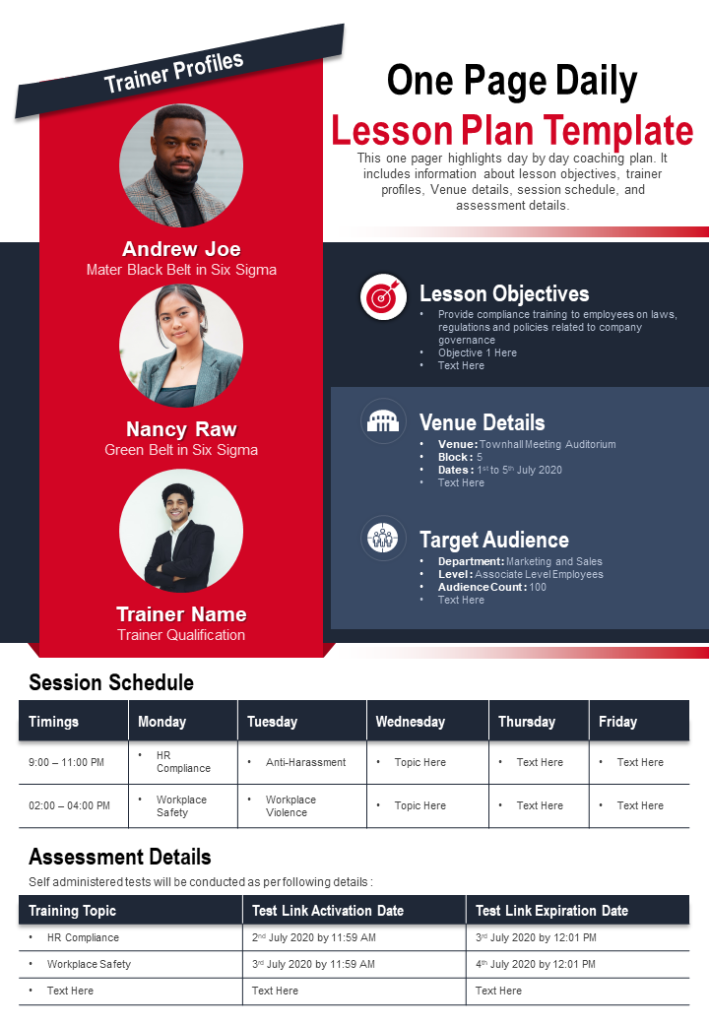
Template 3: One-Page Mentoring Lesson Plan Template
Mentoring can provide the mentor and the mentee a sense of fulfillment. However, you must first develop a lesson plan before beginning mentoring. Here's a simple template that includes all the core lesson planning components.
It is explicitly created to outline your initiative and get the most out of it from start to finish. You can also use it to mention trainer and trainee guidelines to prepare for the session in advance. Grab it now!
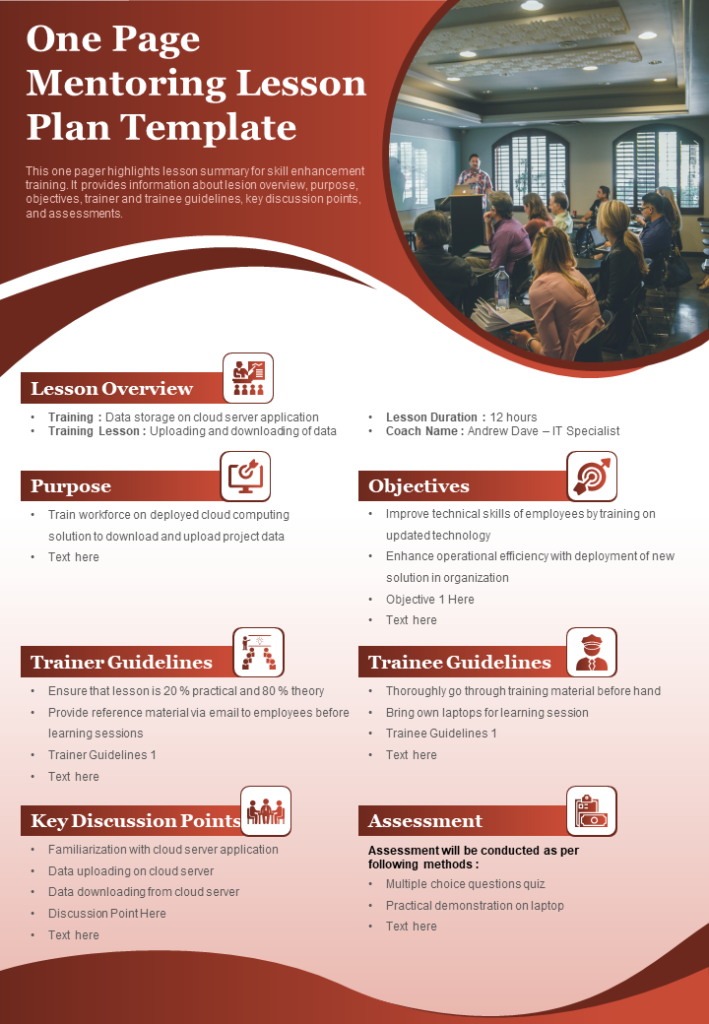
Template 4: One-Page Monthly Lesson Plan Template
Creating monthly lesson plans is one of the most challenging tasks for a novice instructor. You don't know what standards to cover, what activities to include, or how much time to allow for each topic. Don't be discouraged!
Rather, consider this innovative PPT design to outline monthly lesson schedules, case study submission dates, lesson agenda, and more. It can help you develop and manage a new approach to your teaching methods. Download it now!
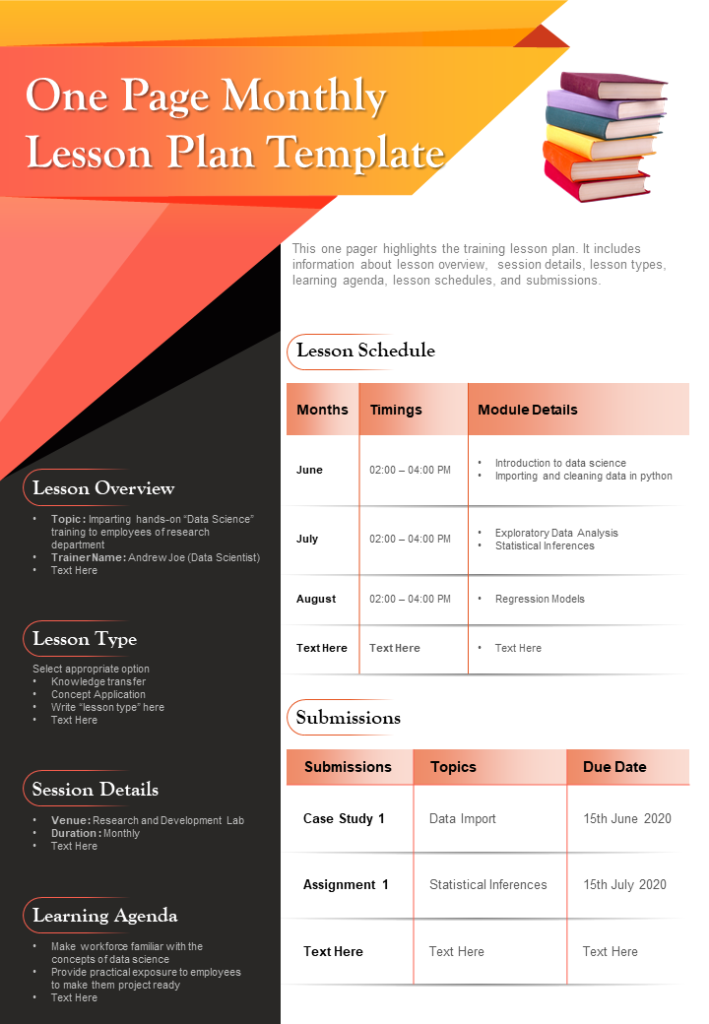
Template 5: One-Page New Joinee Training Lesson Plan Template
If your new staff finds your training tedious and ineffective, consider our exclusive pre-designed template to help you train and plan your activities. This one-pager highlights the mentoring plan for recruits.
Here you can cover the details such as learning objectives, audience details, resources required, standard instructions, and more. By following this roadmap design, your staff can understand everything they need to know about the new position and make a genuine contribution. So don't put it off any longer; download it now!
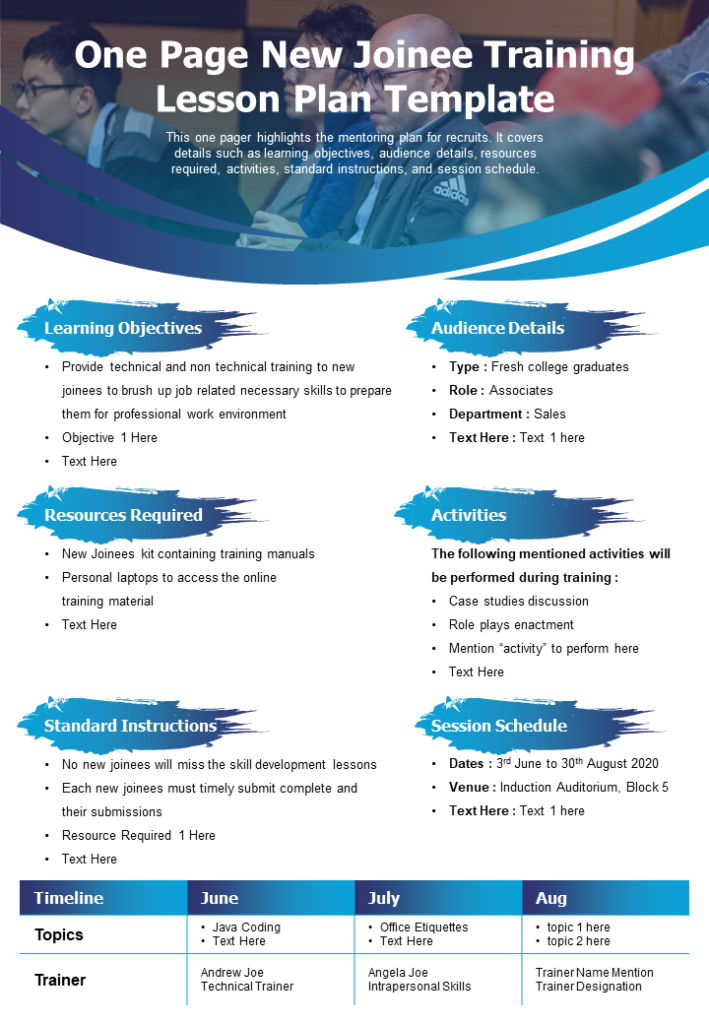
Template 6: One-Page Weekly Infant Lesson Plan Template
A daily schedule for children is unquestionably essential to their development and general happiness. This is why we've got an infant lesson plan template ready for you to follow.
This handy PPT template lets you organize new ideas to keep your children occupied throughout the day. Utilizing this template allows you to plan activities for music, language, indoor games, and motor skills for the little munchkins. Additionally, it also has a space to mention the different things they enjoy doing. So download away!
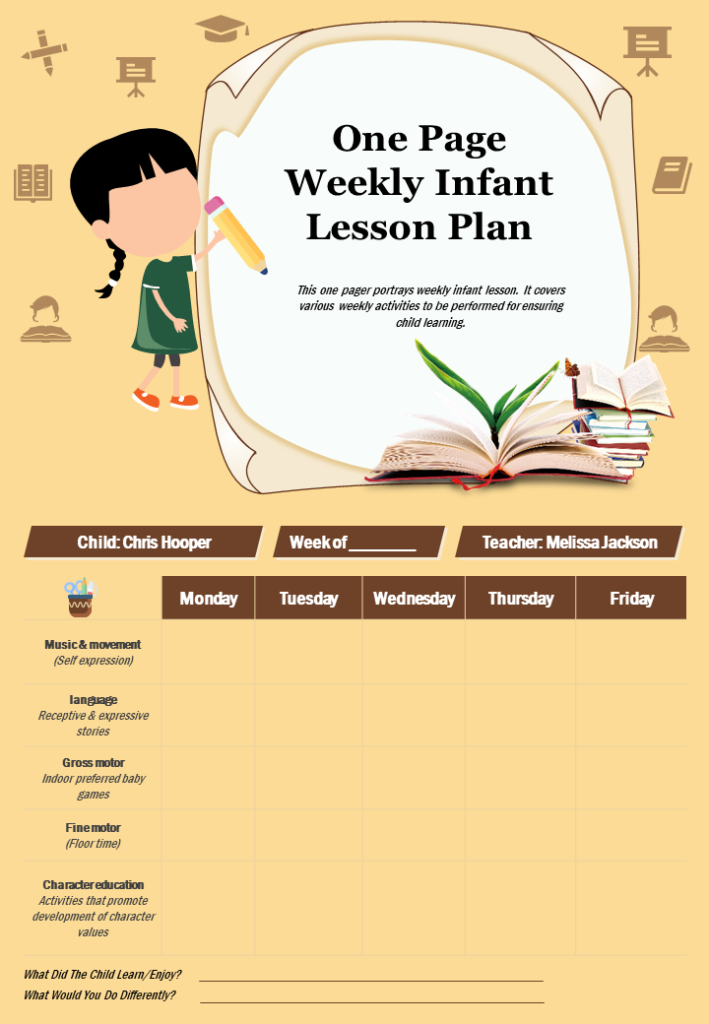
Template 7: One-Page Weekly Preschool Lesson Plan Template
A weekly lesson plan is a perfect approach to ensure your children get the most out of their education. So here's an appropriate and exciting blueprint created especially for preschoolers.
This versatile template can project various themes and subjects to drive your kids' interest in learning. You can also describe different language concepts and goals for a week in this layout. So latch on and create an appealing strategy to educate and build upon the toddlers' knowledge.
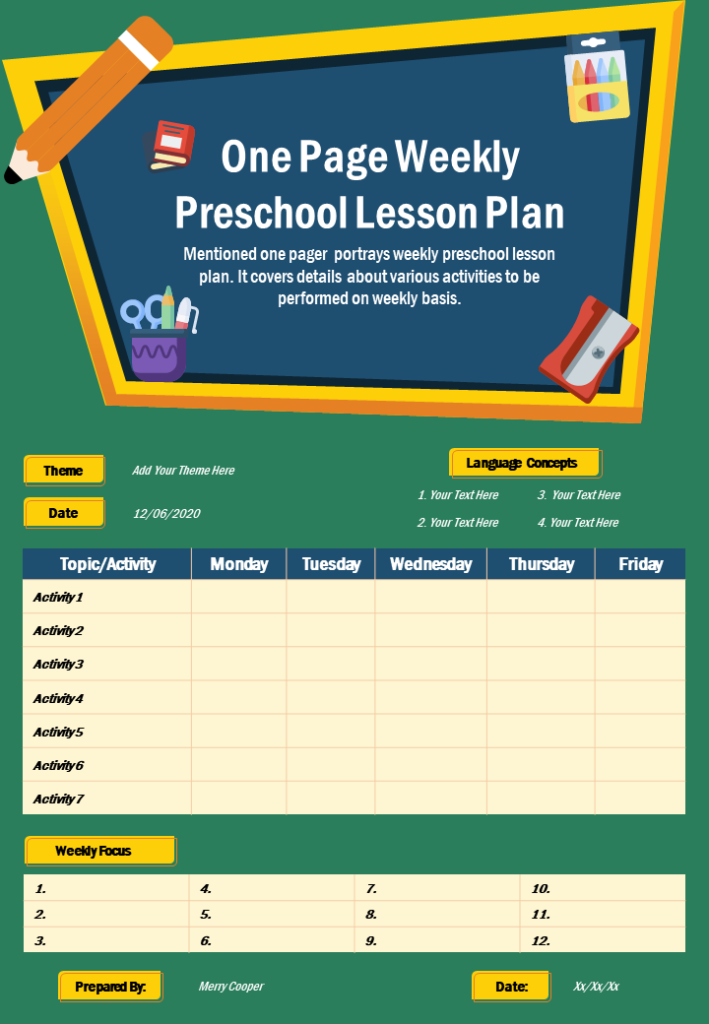
Template 8: One-Page High School Weekly Lesson Plan Template
Imagine having to teach 20-25 high school students in 50 minutes. Would you rather wing it or go with a strategy? A lesson plan is a fundamental approach that guarantees success here.
Hence, consider this PPT layout for making your tutorials more intriguing. This one-page lesson plan allows you to highlight various approaches to learning progression and styles. Therefore, grab it now!
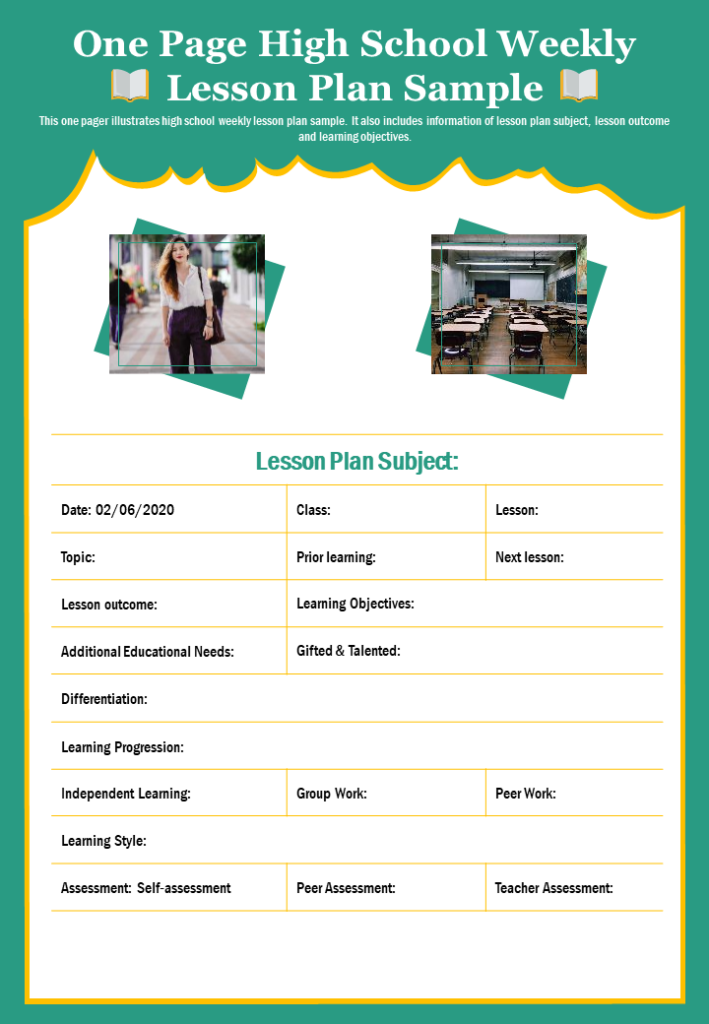
Template 9: One-Page Preschool Weekly Lesson Plan Template
Every preschooler needs some fun. However, this does not negate the need for teachers to plan for weekly activities. Here's an exclusive template to draft the lesson plan that allows the teacher to consider the growth phase of children and set achievable goals.
With the help of this handy layout, you can structure a curriculum of fun-filled and innovative activities to keep the tiny tots engaged. In this theme-based layout, you can also mention the tasks and props for skill development classes. Download it now!
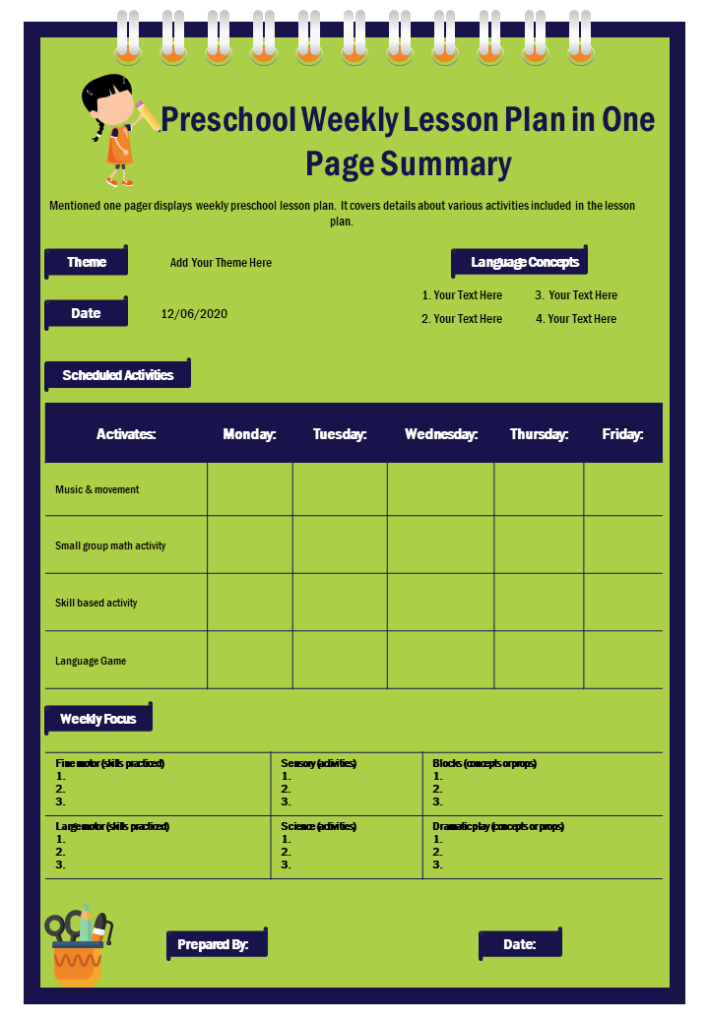
Template 10: One-Page Weekly Lesson Plan Template for High School
Some teaching action plans are more successful than others, but it's challenging to determine which ones until you experiment. Here we present one of the most popular lesson plan templates that high school instructors can incorporate.
This helpful template can streamline your objectives and goals so that students aren't overwhelmed. It covers weekly activities for main subjects and also has ample space to plan for different add-on subjects. Download it right now to enjoy stress-free teaching!
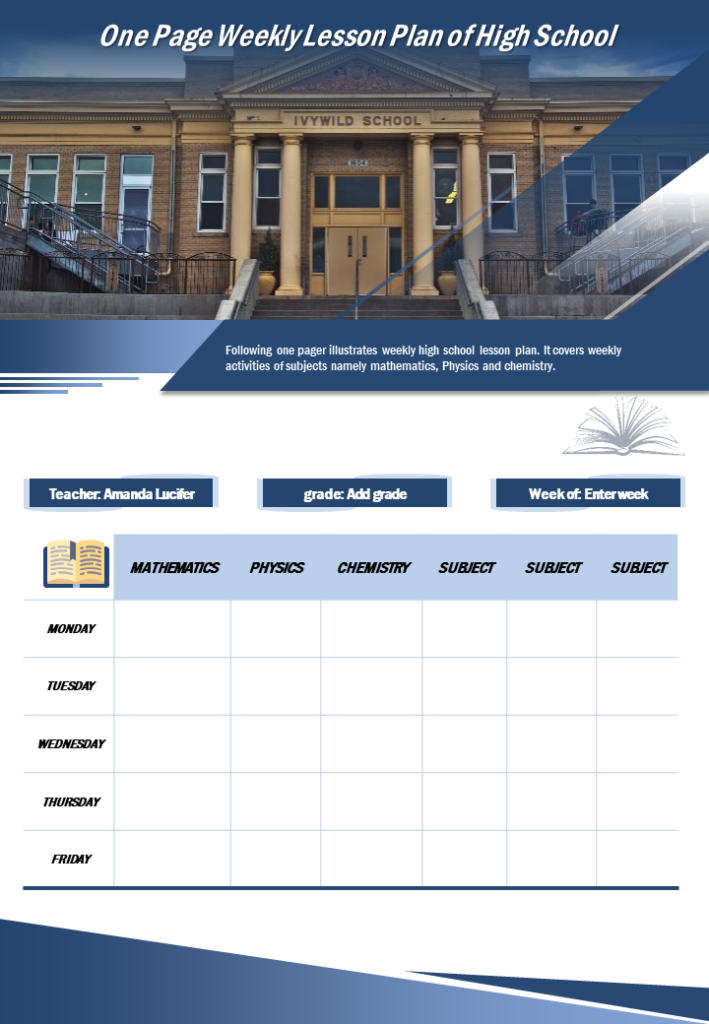
Template 11: One-Page Lesson Plan Template for Professors
There are numerous activities to track and follow when you're a professor. But unfortunately, it becomes hard to find the time to learn new research advances or upcoming events. That's where this lesson plan template comes in handy!
This simple layout makes it easy for you to plan your sessions innovatively and incorporate new learnings. With this PPT template you can describe everything, from the overview to the outcomes of your classes. It also lets you keep track of home assignments. Download it now and focus more on delivering compelling lectures!
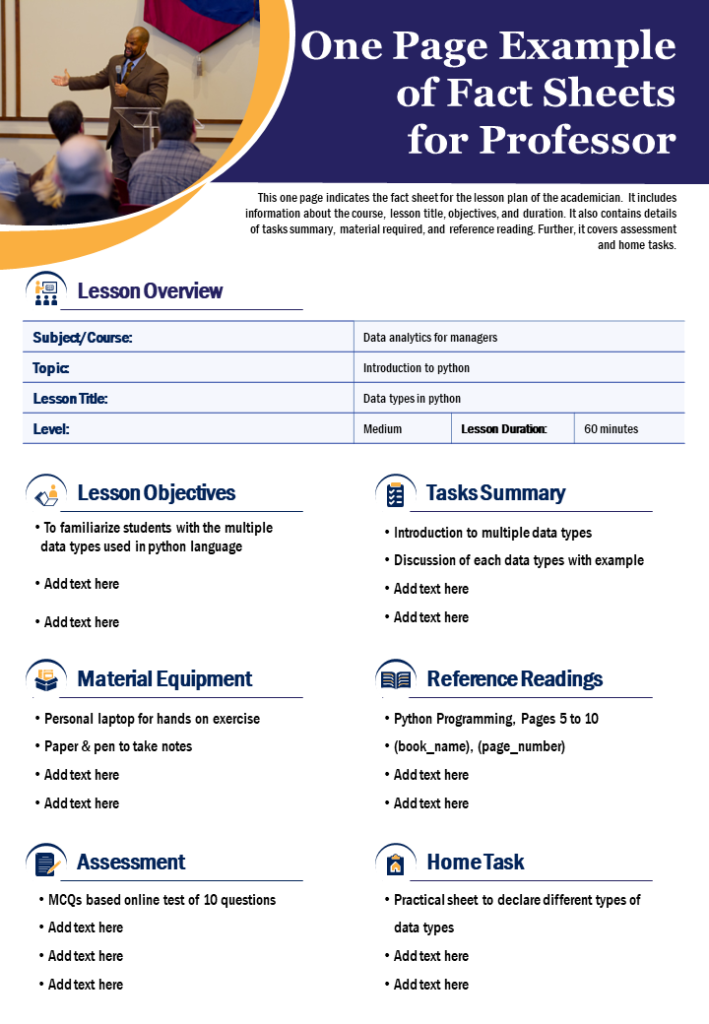
The endnote
We hope that by now, you're eager to empower your students and show them how learning new things can open many doors for them. So download your favorite lesson plan templates and start working on systematic and versatile teaching practice right away! We'd also like to hear about your personal experience. So add your comments below!
P.S: If you are an educator and want to ensure institutional success, here’s an education plan guide packed with stunning templates.
Download the free Lesson Plan Template PDF .
Related posts:
- 11 Professional Use Case PowerPoint Templates to Highlight Your Success Stories
- 35 Best Matrix Chart PowerPoint Templates To Make Better Decisions!
- 40 Best Lego Blocks PowerPoint Templates To Unlock Your Hidden Talent
- [Updated 2023] 50 Best Company Presentation Templates To Ace The Corporate Ladder
Liked this blog? Please recommend us

[Updated 2023] Top 20 Coaching and Mentoring Templates in PowerPoint for Leadership Development
![presentation in lesson plan example [Updated 2023] Top 40 School PowerPoint Templates For Teachers And Students](https://www.slideteam.net/wp/wp-content/uploads/2020/03/Banner-14-335x146.png)
[Updated 2023] Top 40 School PowerPoint Templates For Teachers And Students
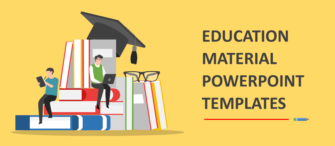
Top 20 Educational Material PowerPoint Templates for Students and Educators
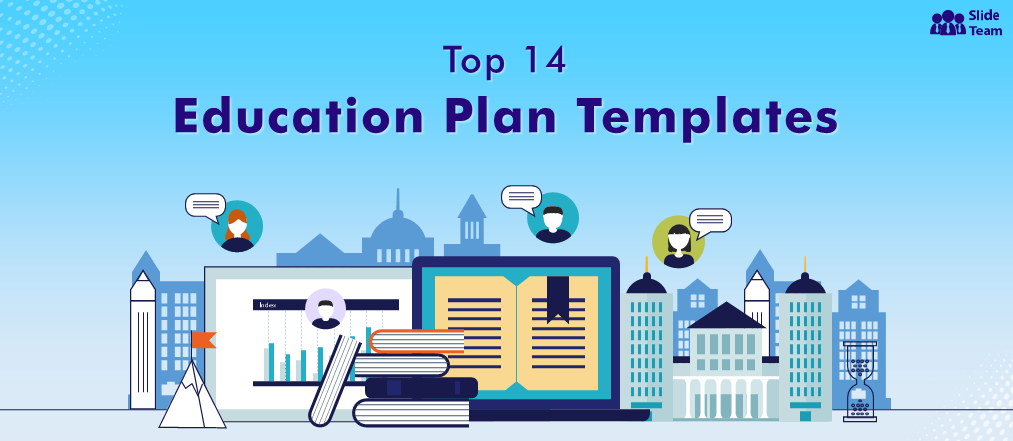
Top 14 Education Plan Templates to Ensure Institutional Success
This form is protected by reCAPTCHA - the Google Privacy Policy and Terms of Service apply.

Digital revolution powerpoint presentation slides

Sales funnel results presentation layouts
3d men joinning circular jigsaw puzzles ppt graphics icons

Business Strategic Planning Template For Organizations Powerpoint Presentation Slides

Future plan powerpoint template slide

Project Management Team Powerpoint Presentation Slides

Brand marketing powerpoint presentation slides

Launching a new service powerpoint presentation with slides go to market

Agenda powerpoint slide show

Four key metrics donut chart with percentage

Engineering and technology ppt inspiration example introduction continuous process improvement

Meet our team representing in circular format

- PRO Courses Guides New Tech Help Pro Expert Videos About wikiHow Pro Upgrade Sign In
- EDIT Edit this Article
- EXPLORE Tech Help Pro About Us Random Article Quizzes Request a New Article Community Dashboard This Or That Game Popular Categories Arts and Entertainment Artwork Books Movies Computers and Electronics Computers Phone Skills Technology Hacks Health Men's Health Mental Health Women's Health Relationships Dating Love Relationship Issues Hobbies and Crafts Crafts Drawing Games Education & Communication Communication Skills Personal Development Studying Personal Care and Style Fashion Hair Care Personal Hygiene Youth Personal Care School Stuff Dating All Categories Arts and Entertainment Finance and Business Home and Garden Relationship Quizzes Cars & Other Vehicles Food and Entertaining Personal Care and Style Sports and Fitness Computers and Electronics Health Pets and Animals Travel Education & Communication Hobbies and Crafts Philosophy and Religion Work World Family Life Holidays and Traditions Relationships Youth
- Browse Articles
- Learn Something New
- Quizzes Hot
- This Or That Game New
- Train Your Brain
- Explore More
- Support wikiHow
- About wikiHow
- Log in / Sign up
- Education and Communications
- Creating Lesson Plans
How to Build a Lesson Plan: Templates, Requirements, and More
Last Updated: April 7, 2024 Fact Checked
Sample Lesson Plans
Constructing a lesson plan, adjusting your lesson plans efficiently, presenting the lesson, expert q&a.
This article was co-authored by César de León, M.Ed. and by wikiHow staff writer, Eric McClure . César de León is an Educational Leadership Consultant and currently serves as an Assistant Principal for the Austin Independent School District in Austin, TX. César specializes in education program development, curriculum improvement, student mentorship, social justice, equity leadership, and family and community engagement. He is passionate about eradicating inequities in schools for all children, especially those who have been historically underserved and marginalized. César holds a Bachelor’s degree in Education and Biology from Texas State University and a Master’s degree in Educational Leadership from The University of Texas at Austin. There are 20 references cited in this article, which can be found at the bottom of the page. This article has been fact-checked, ensuring the accuracy of any cited facts and confirming the authority of its sources. This article has been viewed 3,789,830 times.
As a teacher, developing a thoughtful lesson plan is an essential part of your job. Not only do your lesson plans lay out everything you’ll do in a given class, but they can be shared with subs to complete your lessons when you’re out sick, and administrators can use them to provide feedback and monitor your classroom. While writing a lesson plan may seem like a daunting task at first, take it from a former teacher that they’ll soon become second nature. In this article, we’ll walk you through what you need to include in each lesson plan, show you how to use your lesson plan to make you a better teacher, and walk you through what a class might look like based on your plans.
Things You Should Know
- A lesson plan outlines what you’ll teach in a given lesson and provides justification for why you’re teaching it.
- Every lesson plan needs an objective, relevant standards, a timeline of activities, an overview of the class, assessments, and required instructional materials.
- Overplan in case your lesson ends early and tailor your plans to suit the needs of your students.

- An example of a good objective might be, "Students will be able to analyze nonfiction texts by performing a close reading on a historical document."
- Most teachers will use Bloom’s taxonomy when choosing their objective verb.
- Teachers often abbreviate “Students will be able to” with “SWBAT” on their lesson plans.
- Many teachers start with the objective then work their way out from there, choosing class activities last. This is called “backmapping” and it’s the most widely accepted lesson organization style around today. [2] X Research source

- Our previous objective aligns nicely with the CCSS R.L.8.2, which reads “Determine a theme or central idea of a text and analyze in detail its development over the course of the text…”
- A handful of states, including Florida, Virginia, and Texas, refuse to adopt common core. They have their own state standards.
- If you’re still in school to become a teacher, you may not have specific standards you need to cover just yet.
- Many schools will allow teachers to cover the objectives in whatever order they’d like so far as they cover all of them. Some schools will map out the standards to cover in their curriculum, though.

- For example, if your class is about Shakespeare's Hamlet , your overview might be “Introduction to Hamlet . Historical context, biographical info, and preliminary information. We’ll cover the folio, character list, and assign reading roles. Start Act 1 if time allows.”
- A single overview may get you through multiple classes, so you may find yourself copy and pasting the same overview into multiple plans. That’s totally okay!

- 1:00-1:10: Warm up . Bring class into focus and recap yesterday's discussion on great tragedies; relate it to Hamlet .
- 1:10-1:25: Present information. Discuss Shakespearean history briefly, focusing on his creative period 2 years before and after Hamlet.
- 1:25-1:40: Guided practice . Class discussion regarding major themes in the play.
- 1:40-1:55: Freer practice. Class writes single paragraph describing current event in Shakespearean terms. Individually encourage bright students to write 2 paragraphs, and coach slower students.
- 1:55-2:00: Conclusion. Collect papers, assign homework, dismiss class.

- Formative assessments are instructional tools. They’re anything you use to check if students are learning so you can adjust your lessons. Examples include: class discussions, teacher questions, pop quizzes, group work, surveys, and self-reflections.
- Summative assessments are how you prove a student learned something. They occur at the end of lesson arcs, units, or sections. Examples include: tests, quizzes, essays, presentations, and final projects.
- All summative assessments (outside of tests and quizzes) have rubrics, which are the set of standards you’re judging students on. You do not need to include your rubrics in the lesson plan, but you should be making rubrics.

- You might list textbooks, worksheets, novels, calculators, or whiteboards. If you need to borrow a TV or need a link to a specific YouTube video, include that, too.
- Skip the basic school supplies every student needs. You don’t need to mention pens, pencils, etc.
- Need a worksheet or special materials for a class but don’t want to spend super long making them from scratch? Check out Teachers Pay Teachers . Seasoned educators sell their instructional material to other teachers for cheap!

- Over time, you’ll need to do this less and less. Eventually, you'll be able to go in with practically nothing at all!

- If you find yourself constantly running over your schedule, know what you can and cannot scratch. What must you cover in order for the children to learn most? What is just fluff and time killers?

- Odds are you'll be working with a pile of extroverts and introverts. Some students will benefit more from working alone while others will thrive in pair work or in groups. Knowing this will help you format activities to different interaction preferences. [11] X Research source
- You'll also wind up having a few students that know just about as much as you do on the topic and some that, while smart, look at you like you're from another planet. If you know who these kids are, you can plan accordingly.
Joseph Meyer
Effective teaching strategies consider a student's individual strengths. Tailoring instruction to a student's existing skills and encouraging collaborative activities can improve a student's outcome. Recognizing diverse learning styles allows for a stronger approach, fostering potential in all learners.

- Really, any activity can be manipulated to be done separately, in pairs, or in groups. If you have ideas already mapped out, see if you can revamp them at all to mix it up.

- Every student learns differently. Some need to see the info, some need to hear it, and others need to literally get their hands on it. If you've spent a great while talking, stop and let them talk about it.
- You will likely have some students with IEPs, or Instructional Educational Plans. These are legal documents for students with special needs that require specific instructional adjustments.

- The easiest thing to do is to come up with a quick concluding game or discussion. Throw the students together and have them discuss their opinions or ask questions.

- Avoid using shorthand or acronyms that only you’ll be able to understand.
Eric McClure
"It helps if your backup lesson plans are very easy to find and clearly labeled as substitute plans. If there are any handouts, print those out ahead of time as well. This is the kind of thing that’s easy to overlook early in the year, but trust me—you’ll need a day off at some point and when you do, you won’t want to come in just to drop off lesson plans."

- The warm up can be a simple game (possibly about vocab on the topic to see where their current knowledge lies (or what they remember from last week!). Or, it can be questions, a mingle, or pictures used to start a conversation. Whatever it is, get them talking and thinking about the topic.

- Go over the objective at the beginning of class! Always let your students know why they’re doing what they’re doing.

- This is often explained by teachers as “I do, we do, you do.” In other words, you show them how to do it. Then, the whole class does it together. Finally, the students do it on their own.
- If you have time for two activities, all the better. It's a good idea to test their knowledge on two different levels -- for example, writing and speaking (two very different skills). Try to incorporate different activities for students that have different aptitudes.

- If you've been teaching the same group for a while, odds are you know the students who might struggle with certain concepts. If that's the case, pair them with stronger students to keep the class going.
- You don't want certain students left behind, but you also don't want the class held up, waiting for everyone to get on the same level.

- It all depends on the subject at hand and the skills you want to use. It can be anything from a 20-minute puppet making project to a two-week long dalliance with the oversoul in a heated debate on transcendentalism.

- If you have a group full of kids that can't be paid to raise their hands, turn them amongst themselves. Give them an aspect of the topic to discuss and 5 minutes to converse about it. Then bring the focus to the front of the class and lead a group discussion. Interesting points are bound to pop up!

- Assign and hand out any homework at the end of the class.

- Don’t worry if lesson planning feels really unfulfilling and pointless to you. A lot of new teachers think they feel like busy work at first—especially when classes don’t go as planned. Luckily, once you finish one year of teaching, you’ll have a full year’s worth of lessons to use! [24] X Research source Thanks Helpful 0 Not Helpful 0
- Lesson plans typically cover a single class period, although a more complex lesson may require 2-3 days to get through. A single lesson plan may also bleed over into multiple classes if there’s a fire alarm, some behavioral issue that requires attention, or you have to modify your schedule due to a school-wide event. Thanks Helpful 0 Not Helpful 1

You Might Also Like

- ↑ https://www.nea.org/professional-excellence/student-engagement/tools-tips/5-tips-improve-your-lesson-plan
- ↑ https://www.calstate.edu/csu-system/why-the-csu-matters/graduation-initiative-2025/co-requisite-mathematics-summit/Handouts/Backmapping_example_and_template.pdf
- ↑ https://drexel.edu/soe/resources/student-teaching/advice/how-to-write-a-lesson-plan/
- ↑ https://iris.peabody.vanderbilt.edu/module/cnm/cresource/q4/p16/
- ↑ https://poorvucenter.yale.edu/Formative-Summative-Assessments
- ↑ https://jan.ucc.nau.edu/~slm/AdjCI/Lessonplan/Elements.html
- ↑ https://awildsurmise.medium.com/improving-teaching-scripting-5950e1d15f54
- ↑ https://assets.publishing.service.gov.uk/government/uploads/system/uploads/attachment_data/file/511257/Eliminating-unnecessary-workload-around-planning-and-teaching-resources.pdf
- ↑ César de León, M.Ed.. Educational Leadership Consultant. Expert Interview. 11 November 2020.
- ↑ https://onlineprograms.ollusa.edu/ma-in-counseling/resources/learning-styles-of-introverts-and-extroverts
- ↑ http://www.auburn.edu/~nunnath/engl6240/seating.html
- ↑ https://teach.com/what/teachers-know/learning-styles/
- ↑ https://www.ascd.org/el/articles/pacing-lessons-for-optimal-learning
- ↑ https://www.chalk.com/introduction-to-lesson-planning/why-lesson-plan/
- ↑ https://www.edutopia.org/blog/having-an-off-day-josh-stock
- ↑ https://poorvucenter.yale.edu/teaching/teaching-how/chapter-2-teaching-successful-section/running-class
- ↑ https://readingrecovery.clemson.edu/home-2/reading-comprehension/lesson-structure/guided-practice/
- ↑ https://www.teachingenglish.org.uk/professional-development/teachers/knowing-subject/d-h/free-practice
- ↑ https://teaching.cornell.edu/teaching-resources/engaging-students/using-effective-questions
- ↑ https://www.tefl.net/elt/ideas/younglearners/finishing-preschool-english-lessons/
About This Article

If you need to make a lesson plan, start by creating a timeline based on the length of the class or the school day. As you get to know your class throughout the year, try to tailor your lesson plan to their strengths. For instance, some groups might learn better by taking notes during a lecture, while others might benefit more from group discussions or worksheets. Try to include several different activities during each class period so the kids don’t get bored, and also to appeal to the different learning styles in the classroom. Read on for sample lesson plans and more tips on how to budget your time! Did this summary help you? Yes No
- Send fan mail to authors
Reader Success Stories
Emamihwo D.
Did this article help you?

Jabulani Simelane
Feb 19, 2020
Charletha Porter
Feb 16, 2020
Xolani Lingela
May 8, 2017
Deborah Amaral
Jan 1, 2020

Featured Articles

Trending Articles

Watch Articles

- Terms of Use
- Privacy Policy
- Do Not Sell or Share My Info
- Not Selling Info
Get all the best how-tos!
Sign up for wikiHow's weekly email newsletter
Got any suggestions?
We want to hear from you! Send us a message and help improve Slidesgo
Top searches
Trending searches

suicide prevention
8 templates

46 templates

tropical rainforest
29 templates

spring season
34 templates

american football
16 templates

32 templates
Mative Lesson Plan
Mative lesson plan presentation, free google slides theme, powerpoint template, and canva presentation template.
Slidesgo will always get your back, teacher! Be sure to work on your lesson plans without any problems by using this template to keep everything organized and at hand. The resources are mostly linear rectangles and the backgrounds are nice to look at, with colorful abstract shapes that don't distract at all. We've even included sections for each week of the month!
Features of this template
- 100% editable and easy to modify
- 30 different slides to impress your audience
- Available in five colors: Yellow, Purple, Pink, Green and Blue
- Contains easy-to-edit graphics such as graphs, maps, tables, timelines and mockups
- Includes 500+ icons and Flaticon’s extension for customizing your slides
- Designed to be used in Google Slides, Canva, and Microsoft PowerPoint
- 16:9 widescreen format suitable for all types of screens
- Includes information about fonts, colors, and credits of the free resources used
How can I use the template?
Am I free to use the templates?
How to attribute?
Attribution required If you are a free user, you must attribute Slidesgo by keeping the slide where the credits appear. How to attribute?
Available colors.
Original Color
Related posts on our blog

How to Add, Duplicate, Move, Delete or Hide Slides in Google Slides

How to Change Layouts in PowerPoint

How to Change the Slide Size in Google Slides
Related presentations.

Premium template
Unlock this template and gain unlimited access

Register for free and start editing online

- Search Search Search …
Interactive lesson planner template, a one-stop shop.
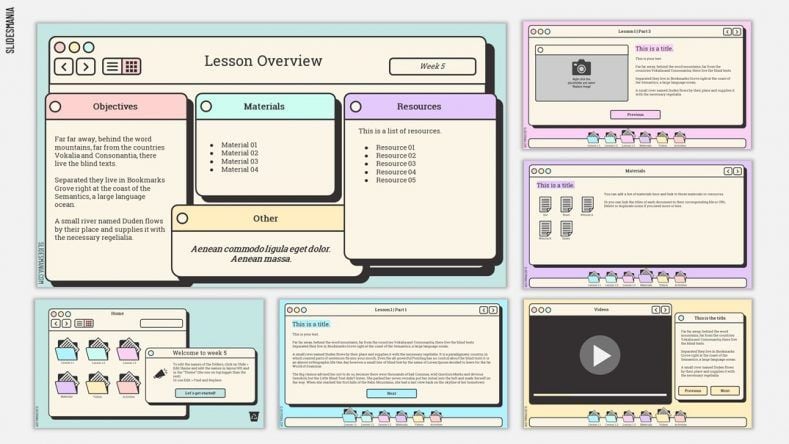
Free PowerPoint template and Google Slides theme.
Lesson plan like a boss with this free interactive template. organize your lessons, resources and activities and present them to your students in this one-stop shop learning station..
Gather all the resources (videos, images, links and text) in this template and deliver your lessons like a boss. Perfect for blended learning.
You can use the Lesson Overview slide for your morning meetings too!
To edit the names of the folders, click on Slide > Edit theme and edit the names in layout 001 and in the “Theme” (the one on top bigger than the rest) Or use Edit > Find and Replace!
Remember that when working with linked slides, if you need more slides per “folder” you need to duplicate an existing slide within that folder. You can copy and paste the “previous” and “next” buttons – they already are linked to go back or forth.
If you wish to change its colors, check out this how to and change its accents!
If you need more folders, it will require to edit the theme. Copy and paste and existing one on the theme slide, and save the new folder in your clipboard, then close the theme (master) and duplicate any slide within a folder, paste the folder icon on top of the new one and make it a bit bigger. Insert a transparent shape on top of the new folder and link it to the new slide. Copy and paste this linked shape on each slide.
You may also like
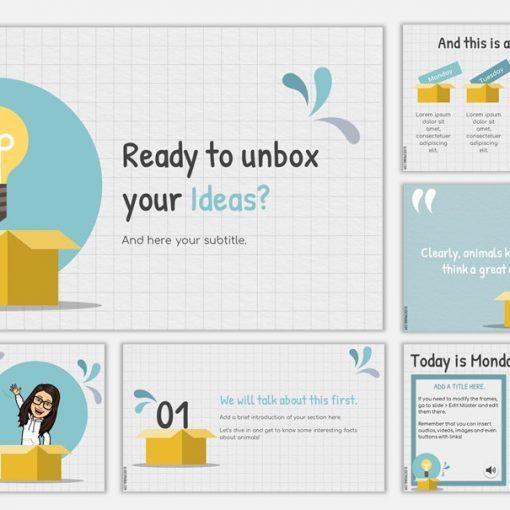
Unbox your ideas presentation template.
Free PowerPoint template and Google Slides theme. Unbox your lesson with this template! It comes with an agenda slide. Are you ready […]
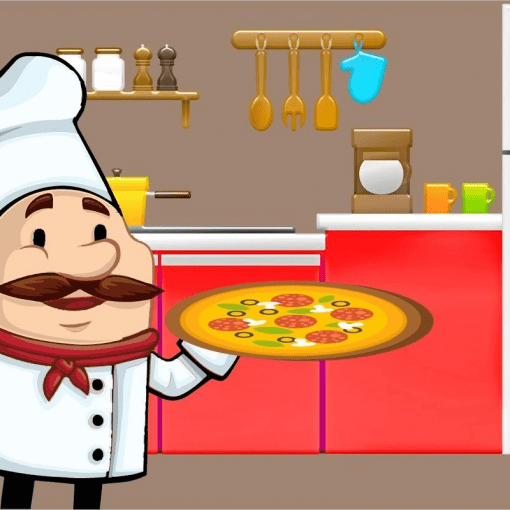
Jamboard for Equivalent Fractions
Get a copy of this template here.
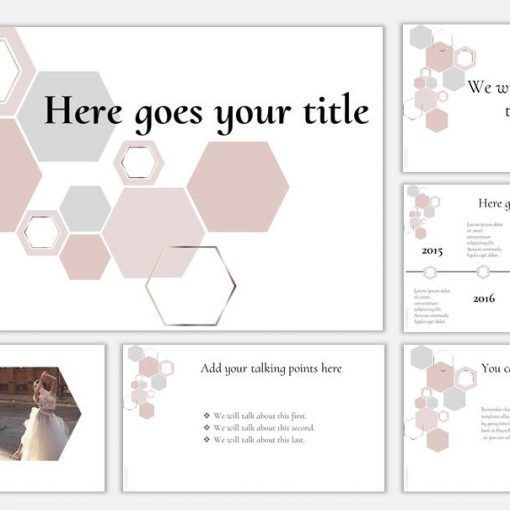
Roskilde Free elegant template for Google Slides or PowerPoint
Free Template for PowerPoint and Google Slides Presentations Roskilde Roskilde is a delicate theme, featuring soft colors, a touch of gold and […]
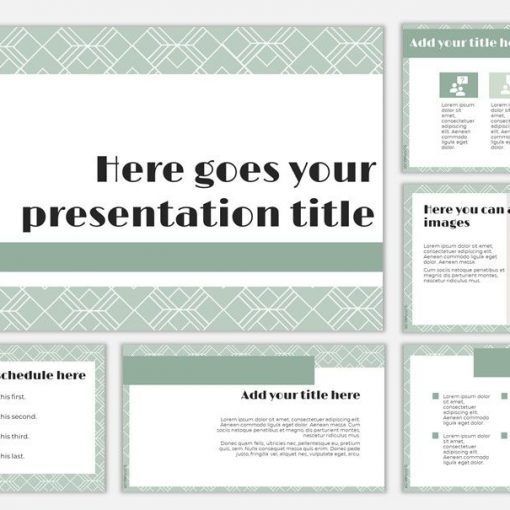
Cooper Free Template for Google Slides or PowerPoint
Free Template for PowerPoint and Google Slides presentations Cooper Cooper is a complete Google Slides or PowerPoint presentation template. Its main colors are white […]

Business English Lesson plan- Giving a Presentation (ESA Framework)

Type of Lesson: Integrated skills (Listening integrated to speaking, pronunciation and vocabulary using authentic material. Theme: giving presentations)
Aims: To identify the characteristics of a good and bad presentation To introduce vocabulary related to presentations To review sentence stress and intonation patterns for effective presentations.
Outcome: By the end of the lesson, students will be able to give a sales presentation about their companies’ new product.
Read: 5 Great Activities to Use with Your Business English Students!
Read: How to Conduct a Needs Analysis for Your Business English Class
Assumptions: Students have a wide range of vocabulary related to the business field. They are able to articulate full sentences using complex and compound sentences. They are aware of how important intonation is when delivering a message. They are able to differentiate intonation patterns. They will already know many adjectives that are used to describe the product they sell at their company, as they will have used them in their own language while performing sales pitches. They have prior experience in giving presentations in their own language and have given presentations in previous ESL classes. They are familiar with the structure of a presentation: introduction, overview, state points, state results and conclusions, summarize, and close.
– Save $100 with the TESOL Diploma and Teaching Business English Specialist Package! –
Students background information: Students are to give a sales presentation about their companies’ new product at a business conference. They are well established sales people in Japan and this will be their first time presenting their product in an overseas environment.
Anticipated Problems and Solutions: Students may not be able to recall some ‘great speakers’. In this case, the teacher will suggest people such as Martin Luther King Jr., Steve Jobs, etc. They may have difficulty using proper intonation in certain phrases; this will be solved by demonstration and drilling. They may also have problems with some pronunciation in the intonation exercise. The teacher will be around to assist students with their individual needs.
Aids/Materials: YouTube video “Enhancing Your Presentation Skills”; a vocabulary presentation worksheet; stress and intonation worksheet; Steve Jobs iphone 2007 presentation YouTube Time: approx. 150 minutes
ENGAGE – Business English Lesson Plan
– Learn to create Business English lesson plans online! –
Aim: to introduce the topic of giving presentations and to outline skills and characteristics that lead to a good presentation. Techniques used: questionnaire; discussion; brainstorming Skills: speaking and listening Interactive Pattern: SS Time: 10 minutes
Aids/Materials: handouts with questions/board
Put students into pairs and have them discuss the following questions:
1. What are the characteristics of a great speech/presentation? 2. Who are the greatest speakers that you can think of? 3. Who do you need to give presentations to as a part of your job? What are they about?
Once students have finished discussing in pairs, have an entire class feedback and have students brainstorm the characteristics of a great speech are. (Examples of ideas that will be elicited: eye contact, clear voice, positive body language, etc.).
STUDY – Business English Lesson Plan
20-hour Teaching Business English Course Only $199!
Step 1: introduce words and phrases related to giving presentations Techniques: Gap-filling Skills: Reading and speaking Interactive Patterns: T-S; SS Time: 5-10 minutes
Aids/Materials: Vocabulary: Presentation Language worksheet.
Students will be given a ‘Vocabulary: Presentation Language’ worksheet that uses words and phrases suitable for presentations. They are to work in pairs in order to fill in the blanks of the passage. After students have completed this activity, the teacher will take it up as a whole class and discuss any vocabulary words they were unsure of.
Vocabulary: Presentation Language
Complete the following presentation excerpts using the words below.
after that finally illustrate outline to start with then describe specifically purpose sum up thank tell you
Good morning, everybody. I hope you are all doing well today and I’d like to _______ you all for being here. Today I am here to __________ about our latest product, and more _________ about how it works and what it does. I’d also like to __________ the products’ features and __________ inform you about where you can get it and how. ____________, I’d like to briefly __________ our current marketing policy in Canada. ________, I’ll __________ some of the problems we have encountered in our market share. ___________, I’ll ________ our progress this year and continue on with our main _______ for being here; the product.
Answer Key: thank, tell you, specifically, illustrate, finally, to start with, describe, then, outline, after that, sum up, purpose
Step 2: To identify how important intonation is in delivering a sound presentation Techniques: Elicitation Skills: Listening and speaking Interactive Patterns: T-S Time: 5 minutes Aids/Materials: Vocabulary: Presentation Language worksheet
The teacher will read the excerpt twice. T will ask the students to listen carefully and identify the differences. The first time, T will read it using proper sentence stress (stressing content words: nouns, main verbs, adjectives, adverbs), intonation and tone of voice. The second time, T will read it in a monotone voice. Then T will elicit the difference and which one is more effective and why: T: “Which speech was more effective?” S: “The first one” T: “Why?” S: (Possible answers) “You used expression, your voice changed, you sounded enthusiastic. In the second reading, your sounded dull, boring.”
Read: How to Use the Communicative Approach
Read: How to Use Task-based Learning
ACTIVATE – Business English Lesson Plan
Aim: Practice intonation patterns Techniques: reading aloud Skills: speaking and pronunciation Interactive Patterns: SS Time: 10 minutes
Aids/Materials: “Good and Bad Stress and Intonation” from UsingEnglish.com
The teacher will hand out the worksheet “Good and Bad Stress and Intonation”. Students will work in partners to practice saying the sixteen sentences with both good and bad intonation. The back of the worksheet provides helpful tips in how to express the sentences in the best and worst ways possible. Once students have finished practicing with a partner, they will go over each sentence as a whole class. The teacher will correct them where necessary
Step 1: Aim: to identify characteristics of effective presentations. Technique: note-taking, listen for main ideas Skills: listening and speaking Interactive patterns: S and SS Time: 10-15 minutes Aids/Materials: YouTube video “Enhancing Your Presentation Skills- Killer Presentations” by Doug Jeffries. (about 7:18 minutes)
The teacher will play the video twice to ensure students have a full understanding of the content. Students are responsible for noting at least five presentation skills that Doug Jeffries mentions in the video (Making your audience comfortable, establishing eye contact, ‘power of the pause’, body language/gestures, effective content). They will then go over and discuss the importance of each point as a whole class. For example:
T: “Why is establishing eye contact important when giving a presentation?” S: “It engages the viewer and allows them to know that you are speaking directly to them”
The teacher will now ask students if they know who Steve Jobs was and what he was responsible for.
T will tell the students that they will now watch a presentation by Steve Jobs and they have to discuss the following questions:
– Can you identify any of the presentation skills described by Doug Jeffries in Steve Jobs’ video?
– What makes Steve Jobs’ iphone 2007 launch presentation effective? (Possible answers: visuals, timing of speech accompanied by visuals, clear voice, confidence, knowledge of product).
– How does he keep the audience engaged? (Possible answers: movement, gestures, tone/pitch, humour, repetition (“re-invent, revolutionary”)
T will ask students to take a closer look at Steve Jobs’ presentation. T will direct them to identify any words they think made his presentation effective; words he repeated, words that they think helped to describe/promote his product. Students should pick out certain adjectives such as revolutionary, life-changing, re-invent, magic, etc. T will write students’ answers on the board and then ask them to think of other vocabulary words they could use to sell a product, focusing on a product that the company they work for sells. “If you were to sell your company’s new product in a presentation like Steve Jobs’, what type of words would you use to engage the audience and make them want to buy your product? Come up with as many adjectives as you can to promote your product.” Students will compile an individual list. Once they have finished their lists, they will discuss their adjectives together as a class. T will write their ideas on the board, adding to the list that we compiled from Steve Jobs’ presentation and give the students time to copy any of the adjectives that they wish to use for their presentations into their notes.
Aim: Students will create a presentation with the assistance of ICT tools (PowerPoint/Camtasia) to sell a product to their classmates using appropriate vocabulary and body language. Techniques: collaborative writing and discussion Skills: Speaking, listening, reading and writing Aids/Materials: computers with Camtasia program and Microsoft PowerPoint Interactive Pattern: SSS Time: approx. 50 min.
For the final stage of the lesson, T will tell students that they are going to create a presentation, much like the one they viewed in the Steve Jobs video, using ICT tools (Camtasia or Powerpoint) to sell a product of their choice. The product must be something they are fully aware of as they will not have much time to research.
T will briefly go over the main stages of a presentation. Students’ presentation must follow this format: introduction, overview, state point, state results, summarize, and close.
Other points to remember to use in their presentations are: -use of vocabulary (adjectives and phrases) to describe the product -body language, gestures and intonation -synchronization of their speech with the slideshow presentation
After each student presents, the rest of the class will give them feedback regarding their presentation (both good and bad) and what they need to work on for a real life sales presentation scenario.
Adapted from lesson plan by 120-hour TEFL certificate graduate.
Take a TESOL course with Teaching Business English specialist!
Leave a Comment
Your email address will not be published. Required fields are marked *
This site uses Akismet to reduce spam. Learn how your comment data is processed .
Topic: Presentation Skills

As you can see in the slide (giving presentations)
Step into the world of presentations with this handy lesson! Students explore vocabulary for structuring presentations, read the text of a presentation and watch a video on how to communicate ideas clearly.

Presentation: putting skills into action
With this lesson plan, students practise giving a presentation in English by doing a lot of different speaking activities. The lesson is the third of the three-part series of lessons about delivering presentations.
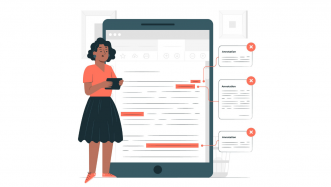
Moving through your presentation
With this lesson plan, students learn plenty of useful phrases for presentations in English. They also prepare presentation excerpts, and learn how to start a presentation. The lesson is the second of the three-part series of lessons about delivering presentations.
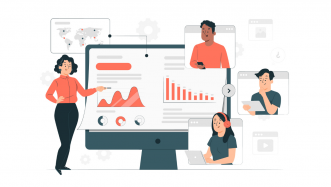
How to nail that presentation
In this lesson about business presentations in English, students discuss presentation structures in depth, watch a video with tips on giving presentations, and learn useful words and phrases related to the topic. The lesson is the first of the three-part series of lessons about delivering presentations.

The city of the future is here
With this lesson plan based on a video about Toyota’s city of the future students learn some useful language for presentations and then practise their presentation skills.

The chair that conquered the world
This lesson plan about the chair that conquered the world includes a variety of tasks for students to learn new vocabulary related to describing furniture design and practise their presentation skills.

How do you like your milk?
In this lesson, students will learn advanced cooking verbs, discuss different types of milk and do an English class project.

Apple’s legendary keynotes
The objective of this lesson plan is to teach students some adjectives for describing products and show them a video analysing Apple’s legendary keynotes.
Presentations
Type of English
Lesson time
I want to learn

LESSON PLAN FOR ENGLISH TEACHERS

Level: Intermediate (B1-B2)
Type of English: Business English
Tags: meetings visual aids giving a presentation Situation based
Publication date: 07/20/2021
Students briefly discuss their own experiences of presentations before identifying types of diagrams often used in presentations and their functions. They listen to a business presentation and identify and practise a range of functional language for structuring presentations. The lesson includes vocabulary development and a presentation activity which can be extended to include preparation of slides with visual aids. Students should prepare and practise their presentation as homework and deliver it in another lesson. The materials also include an optional extension activity relating to what can go wrong with a presentation.
by Stephanie Hirschman
presentation_BrE.mp3
very useful to enhance my students' listening skill
Leave a Comment
Student worksheet
Teacher lesson plan
Download audio
Save lesson to
Students briefly discuss their own experiences with presentations before identifying types of diagrams often used in presentations and their functions. They listen to a business presentation and identify and practice a range of functional language for structuring presentations. The lesson includes vocabulary development and a presentation activity which can be extended to include preparation of slides with visual aids. Students should prepare and practice their presentation as homework and deliver it in another lesson. The materials also include an optional extension activity relating to what can go wrong with a presentation.
presentations_AmE.mp3
COURSE PLANS
This comprehensive course plan covers the full range of language needs – listening, role play, vocabulary development.
Worksheets in English for Work and Life course plan
Type of English: Business English Level: Intermediate (B1-B2)
Type of English: General English Level: Intermediate (B1-B2)
Type of English: General English Level: Mixed levels
Worksheets in English for Business course plan
Type of English: Business English Level: Upper-intermediate (B2-C1)
Make your lessons unforgettable
Did you know that your students can review the target language from our worksheets with our Expemo flashcard app? To let your student know, just enter their email address below (multiple emails can be separated with a comma).

IMAGES
VIDEO
COMMENTS
A lesson plan will be the set of subject matter materials you will be teaching during a specific timeframe. The lesson plan should be an index that students can constantly consult to understand better the parts of the learning journey they will go through during each session. Teachers and professors should have a lesson plan template that ...
Begin with the presentation divided into primary or main sections, highlight key definitions, and add infographics and videos to ensure that every student understands the tiniest detail. Additionally, you can get students involved in the lesson plan presentation by asking questions, polling them on key points, or allowing them to follow along ...
Template 5: One-page weekly lesson plan of high school PPT Presentation. This one-page weekly lesson plan presentation PPT Slide empowers educators to create a weekly plan for students. This template enables the delivery of information on each subject, such as mathematics, physics, chemistry, etc.
30 Lesson Plan Examples for Every Grade Level and Subject. Lots of ways to prepare for top-notch learning. By Jill Staake, B.S., Secondary ELA Education. Aug 3, 2023. Writing lessons might be a fun activity for you (all the things you'll do!) or it may be a necessary evil (so many boxes to fill). Either way, it's an important part of ...
Objectives: know your destination. When writing a lesson plan, start by outlining the learning objectives—what you want your students to take from the session and work backward. Having clear and specific goals helps you plan activities for a successful lesson. 2. Welcome to the hook: make 'em want to learn.
Steps to building your lesson plan. Once you've identified the components that need to go into teaching your class, you're ready to use these eight steps to build your lesson plan: 1. Identify the objectives. To build a lesson, you first need to identify the objectives of each class.
PPP is a lesson plan template that consists of Presentation (P1), Practice (P2) and Production (P3), and it's often used for ESL (English as a Second Language) classes. It focuses on giving students a solid foundation for new concepts, then encouraging them to apply these on their own.
Normally a presentation lesson will have an outline like this: Revision of key language areas; Example presentation, which could be from a textbook or given by the teacher; Students are given a transcript or outline of the presentation; Students identify key stages of the example presentation - greeting, introduction, main points in order of ...
Build in a buffer between each session to take care of any unforeseen issues. Say you want to spend 15 minutes on a class presentation; assign 20 minutes to it instead. Having a realistic lesson timeline helps you stay on track, making sure you have enough time to cover all the key areas of your lesson.
Use this lesson plan presentation template to help students understand expectations and stay on track. This template features a soothing color palette to help reassure your students that they can do it, while clearly communicating the important information. Teachers can post this template online so the students will always have access to it.
Elevate your lesson plans with this lesson plan PowerPoint template. Whether you're a teacher, homeschooling parent, or tutor, these templates will help you create engaging and organized lesson plans that captivate your students' attention. With a range of customizable slides, you can easily outline your objectives, activities, and assessments ...
Template 1: One-Page Coaching Lesson Plan Template . Coaching is an excellent approach to teaching new things. So explore our new coaching lesson plan template! This one-page layout has all the essential factors to help you improve your coaching abilities. In this plan you can highlight the training level, module, task flow, and assignments.
1. Warm your students up with a bell ringer activity. At the beginning of every class, the students' brains aren't primed yet for the content. Ease your students into every lesson with a little warm up known as a bell ringer. These are 3- to 5-minute quick activities that serve as introductions to your lesson.
presentation and understand the rationale behind in-class activities. Having a clearly visible agenda (e.g., on the board) will also help you and students stay on track. Reflecting on Your Lesson Plan A lesson plan may not work as well as you had expected due to a number of extraneous circumstances. You should not
Download the "DNA Lesson for High School" presentation for PowerPoint or Google Slides. High school students are approaching adulthood, and therefore, this template's design reflects the mature nature of their education. Customize the well-defined sections, integrate multimedia and interactive elements and allow space for research or group ...
Millions of photos, icons and illustrations. Easily download or share. Get organized and be ready for every class by creating a lesson plan. Customize lesson plan examples from Canva's lesson plan maker and plot every lecture time and student activity for the day throughout the semester with built-in tools to craft visual Canva Docs.
Weekly Lesson Schedule Slide. Break the lesson of the month in 4 weeks and explain the activities scheduled for each period. For example, list the required readings, set dates for class presentations and tests or determine when you're going to post the final grades. This is the most useful and engaging slide of the entire template! Lesson ...
Introducing Expectations for Oral Presentations: A 55-Minute Lesson Plan. 1. Do Exercise: Similarities and Differences Between Writing and Speaking. 1. 3-minute free write about similarities between writing and speaking, especially similarities between writing a paper and giving a presentation. 2. 3-minute free speak with peer partner about ...
Free Google Slides theme, PowerPoint template, and Canva presentation template. Slidesgo will always get your back, teacher! Be sure to work on your lesson plans without any problems by using this template to keep everything organized and at hand. The resources are mostly linear rectangles and the backgrounds are nice to look at, with colorful ...
Lesson plan like a boss with this free interactive template. Organize your lessons, resources and activities and present them to your students in this one-stop shop learning station. Gather all the resources (videos, images, links and text) in this template and deliver your lessons like a boss. Perfect for blended learning.
ACTIVATE - Business English Lesson Plan. Aim: Students will create a presentation with the assistance of ICT tools (PowerPoint/Camtasia) to sell a product to their classmates using appropriate vocabulary and body language. Techniques: collaborative writing and discussion. Skills: Speaking, listening, reading and writing.
Business. In this lesson about business presentations in English, students discuss presentation structures in depth, watch a video with tips on giving presentations, and learn useful words and phrases related to the topic. The lesson is the first of the three-part series of lessons about delivering presentations. Unlimited Plan Show.
The lesson includes vocabulary development and a presentation activity which can be extended to include preparation of slides with visual aids. Students should prepare and practise their presentation as homework and deliver it in another lesson. The materials also include an optional extension activity relating to what can go wrong with a ...